 |
 |




|
 Loading Page. Please Wait... Loading Page. Please Wait... 
|
General Site Information  | |
|---|---|
| Domain: | ragpiano.com |
| Established: | June 1997 |
| Provider: | iPowerWeb |
| Author: | All content written, coded, illustrated, maintained and posted by Bill Edwards |
| Browser Information | |
| Browser: | |
| Cookies: | |
| Language: | |
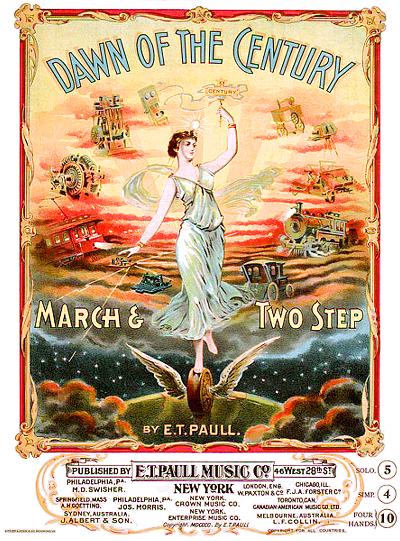


A. (August/Ernest) Hoen & Company  | |
|
Best represented musically by the large remaining cache of E.T. Paull publications, the A. Hoen lithography house hosted some of the finest craftsmen of the trade, adept not only at superb illustrations and mapwork, but the demanding process of color separation onto multiple stones as well. Unfortunately for the sake of historic clarification or recognition, virtually all who worked for Hoen were "company men" whose names have not made it to print, unless they were cleverly concealed within the drawings somewhere.
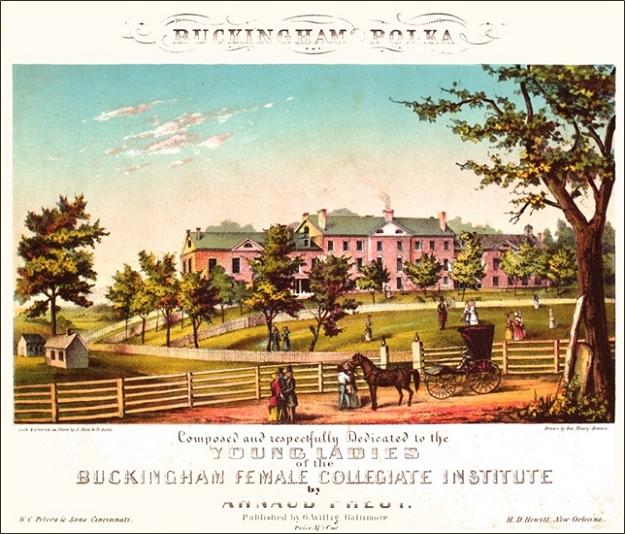 There was also a very coherent and uniform style with most of the Hoen covers and posters, which would make it even harder to distinguish the work of any individual artist. There are employee names throughout the years associated with the firm, but their duties are not clearly known. There was also a very coherent and uniform style with most of the Hoen covers and posters, which would make it even harder to distinguish the work of any individual artist. There are employee names throughout the years associated with the firm, but their duties are not clearly known.The firm was initially started by German immigrant Edward Weber and his nephew Ferdinand August Hoen in Baltimore, Maryland in 1835 as Edward Weber & Company. They printed the first color cards ever produced in the United States and the first lithographic maps printed in the country as well in 1842 for the Fremont Reports, connected to the United States Congressional Reports. August took the firm over with his brother Ernest Hoen and cousin Henry Hoen in 1848 upon Weber's death. Hoen's new firm of A. Hoen & Company not only provided some very fine monochrome and color covers and litho-photography for local Baltimore publishers, but for firms in Washington, D.C. and as far off as the Carolinas.
Some of the artist's names from that era, notably Clayton (a prolific Baltimore engraver), Gillingham, Webb, Duffy and W. French, have been found on some covers. In the 1860s August Hoen patented what he termed the Lithocaustic method of lithography which allowed for easier viewing of the etching in the stone while it was in progress, making the shading of gradients and halftones a much faster process. He prominently displayed a critically acclaimed print from this process in the 1876 Centennial Exposition held in Philadelphia, Pennsylvania. From 1860 to 1883 August was awarded several patents for processes intended to create improved halftone prints with both monochromatic and multi-stone lithography.
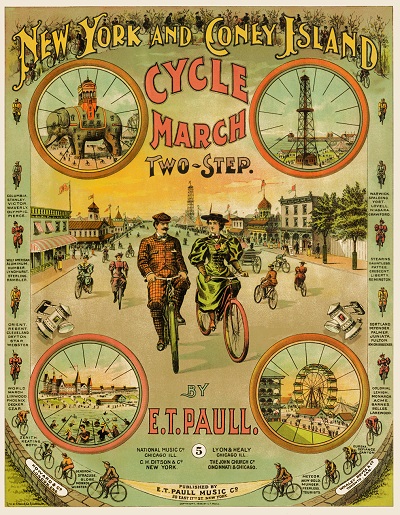
 Henry worked with the Baltimore firm until his death in 1893. Alfred Tennyson Hoen (b. 1873), the youngest of the six sons and three daughters of the founder, ran the A. Hoen lithography firm in Baltimore with older brother Albert Berthold Hoen throughout the early 20th century. August Hoen died in 1886, before the reign of E.T. Paull, but certainly with a well-cemented reputation for top quality prints, very notably on some beautiful cigar boxes. Albert and Alfred were also important contributors of cartography prints done for the U.S. Geological Survey, and later for the Geographical review. Alfred would continue his father's work in creating improvements in the process, particularly in the use of varying grades of lithographic limestone and similar sources. Albert rendered many improvements in setting uniform color standards. The Baltimore branch also produced a few mono and chromolithographic music sheets from the 1860s to the 1880s.
A branch of A. Hoen eventually surfaced in Richmond, Virginia, run mostly by one of August's sons, Ernest August Hoen, who was named after his uncle, assisted by his younger cousin, Ernest's son Edward Weber Hoen, named after the founder. Ernest was a fine musician and music lover who attended Loyola College. August had opened a branch in Richmond, Virginia around the time of the Civil War, and one of their first contracts was to print confederate money. After learning the printing business with his father, he moved to Richmond became the manager in the early 1880s, but it is hard to discern if any of the Baltimore artists followed. Some sources cite 1876 as the year he moved, but Ernest is still shown as working for his father or uncle in Baltimore at the time of the 1880 census, and still living in Baltimore for the 1887 city directory.
In the newer Richmond plant the quality of inks and paper stock, as well as the multi-layer lithography process itself saw great advances, to the point where most Hoen-produced covers and cigar boxes from the 1890s forward still retain their original hues after more than a century. Whereas most sheet music publishers used from one to three colors in simple patterns for their covers, E.T. Paull was looking for something more, and settled on the five color multi-layer process utilized by Hoen, instantly setting his works apart visually and thus creating sales for what the consumer viewed as both music and art. Oldest sibling Adolph G. Hoen eventually moved to Richmond, but his involvement in the firm may be peripheral, as he was listed as a physician in 1910.
The works by the Hoen firm are usually well-marked so their parentage is clear, whether it be maps, cigar boxes, business stationary, posters, or their beautiful sheet music covers over a period of seven-plus decades. Focusing on the era of E.T. Paull, they tended towards not only a high modicum of realism (with very few caricatures), but a level of detail in the backgrounds that most cover artists ignored.
The Baltimore branch of Hoen had been creating lithographic covers since 1848 and chromolithographic sheet music covers since 1851, mostly serving a wide range of Baltimore and Philadelphia music publishers. Among their most frequent Baltimore clients were the firms of George Willig, F.D. Benteen and Henry McCaffrey. However, their sheet music cover output appears to have ended in the mid-1880s.
The Richmond branch of A. Hoen, on the other hand, had no history of providing sheet music cover art before they were contracted for The Chariot Race or Ben Hur March in 1894 by E.T. Paull. It appears that his was the only sheet music they printed covers for (in most cases, the music plates themselves were created elsewhere), it is likely that Paull found some way to convince them that the visibility provided by his music might bring the firm more work at the very least. They were also possibly the only company in Richmond, much less Virginia, capable of the level of artistry he was looking for, with their enormous building covering a full city block, indicating stability and growth. At one point in the mid-1910s there were between 125 and 300 employees [reports vary] working at the Richmond branch.
Whether it was a battle scene or some natural catastrophe, the vivid hues the Hoen firm achieved, often focusing on reds, provided great accent to even the smallest of details such as lava ash or a swinging sword. Even though it is common to display framed sheet music today, it was an honor applied largely to the Hoen works from the Paull catalog during the early 20th century. As Paull engaged the company even after he had moved to New York in 1896, with Hoen covers appearing into the late 1910s, there may be some possibility that some of the production was also done in the Baltimore branch of the firm, but this is difficult to verify as there were no distinct codes or indicators to identify this.
Ernest was an active member of Richmond society and a member of the Wednesday Club as well as the Philharmonic Orchestra of the Westmoreland Club. He was married to Baltimore native Clara Byrne and had two sons, Hudson P. Hoen and Dr. Walter Scott Hoen, a United States Navy surgeon in the 1910s. Ernest had his own printing patent listed in 1907, which consisted of a unique method for printing dispensable tickets. His health started to fail in 1913 and he retreated to Atlantic City, New Jersey in the spring of 1914 to try and recover. It was there that pneumonia took his life in April 1914. His son, Walter, died in July 1918 in Port Au Prince, Haiti, while on Naval duty.
The Richmond branch continued into the early 1930s under Edward Hoen, concentrating on the envelope business. He finally passed in 1941 at age 78. Both of the Hoens are buried at Hollywood Cemetery in Richmond, Virginia. Albert Hoen continued to run the Baltimore office as president of the firm until his death on May 1, 1956 at age 93. The original Baltimore office of the Hoen firm continued in the lithography and printing business until around 1981 when it dissolved after filing for bankruptcy. |

William Starmer and Fredrick Starmer  |
|
Virtually anybody who has even a minimal sheet music collection that includes ragtime-era items likely has a cover done by one of the prolific Starmer Brothers. They had a consistency that was hard to match in terms of creating eye-catching cover art that did justice to or often outshined the contents within. By some accounts, they were responsible for nearly a quarter of all signed covers in large format from 1900 to around 1919, and continued producing cover art into the mid-1940s.
The artists were both born and raised in Leeds, Yorkshire England, William in 1872 and Frederick in 1878, to boot maker James Starmer and Ann Elizabeth Starmer. There was one older brother, Edwin J. Starmer, born around 1868. In the 1891 England census, the family was shown living at the same address in Leeds that they were in a decade prior, and 19-year-old William was listed as a litho-artist or lithographer. The brothers and their father eventually relocated from England to New York City, William in 1898 and Frederick in 1899. James returned to England for a time, followed by William in 1900, who went back to marry Julietta Dawson. He returned to New York shortly thereafter to continue his work. The rest of the Starmer family and Julietta followed in June 1904. The brothers were set up fairly soon as draftsmen and artists. For many years, it was hard to discern that there were two separate Starmers at work, since the covers had similar attributes and they all had the same Starmer signature.
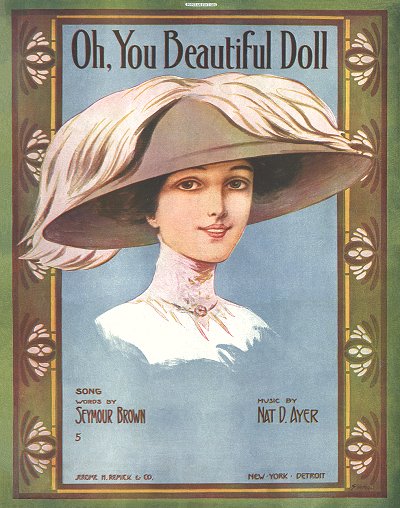
 According to collector Marion Short, it was piano roll and sheet music collector Mike Montgomery who first discovered the identity of at least one of the Starmer brothers through an invoice obtained from the daughter-in-law of publisher Jerome H. Remick, a bill from William Austin Starmer. Curiously, it listed him as an "Artist and Medical Draughtsman" from Long Island. The brothers somehow escaped the 1900 census, but a check of the 1910 census showed that William was the older brother of Fredrick, and that they were immigrants from England. Even though William and Julietta had evidently had a son, William J. Starmer, in 1907, he was also curiously not listed in the record. Both brothers listed artist as their occupation in 1910, with William as "commercial" and Frederick as "illustrating." William and his wife shared their Manhattan apartment with Frederick as well. Both also appeared at the same address in several Manhattan directories of the 1910s into the 1920s, usually with Frederick as draftsman and William as an artist.
The 1920 census showed all of the Starmers still living in the same apartment, with both brothers listed as commercial draftsmen. William's wife Julietta died on February 26, 1922. Passenger manifests of the 1910s and 1920s indicate many trips back to England as well, so they did stay connected with their home country. William was remarried to highly-regarded English teacher Edith Mary White in the summer of 1924 in Bradford, England, her native city. The following year she retired from a 35 year career of teaching, and was widely honored for her service, although in the New York state census for 1925 she still listed teacher as a profession. At the time of the 1930 census William's accountant son, 23 year-old William, Jr., was still living with the couple in Queens. William Sr. listed himself as a commercial artist with his own studio, likely the same situation as in previous years. The retired Mrs. Starmer also was noted in the newspapers frequently as leading the choirs at the Remsen Street Reformed Baptist Church in Queens in addition to her other church activities.
William Starmer made several trips back to England, likely to see family or keep his visa current, from as early as 1907 to the late 1930s before travel restrictions were in place due to the oncoming war. Both brothers sailed there and back in 1905, 1907, 1909, 1913 and 1924. On January 31, 1924, he was naturalized as a U.S. citizen. Frederick appears to have made one final round trip voyage in September 1925 before returning to England for good around 1929. Information on him in the 1930s is difficult to come by at this point, but it is assumed he continued a career in commercial art either in Bournemouth near Dorset. William took subsequent round trip voyages in 1927, 1929, 1936, 1937 and 1938. The 1940 enumeration taken in Queens showed him still listed as a commercial artist.
In the November 12, 1941, Long Island Daily Press, an article about William Starmer, now living in Astoria, New York, stated that Frederick had immigrated back to Bournemouth, England around 1929. Whether he continued his career as a full-time artist is uncertain, but as World War II was started, Frederick had a found another important position in his community: William A. Starmer... a commercial artist, spent Armistice Day in the Astoria Station House, coloring maps of the precinct zones for civilian defense.
He opined that his brother, Fred W. Starmer, 63, also a commercial artist, was equally busy in civilian defense work 3,000 miles away in Bournemouth, England, where Fred is a post warden and has experienced more than 200 air raids since the outbreak of the war.
Laying aside his paints and brushes and other tools for a moment, William related that he and his brother came to this country from England in 1898 and went into business as commercial artists. Fred returned to England 12 years ago.
As soon as the war began, the older brother said Fred began working on defense maps for the sections of Southampton and Weymouth, similar to the job which William is doing.
The older brother, who was one of the first to report to the Astoria police for post warden duty, said he received a letter from Fred several years ago but it was badly cut up [redacted] by the censor and all he could make out was: "I have plenty to tell you." The censor, however, permitted a snapshot to pass
It showed Fred and eight other post wardens wearing their tin hats and gas masks, sitting in a sandbag shelter. William died in New York in February 1957 at age 85, and Frederick followed in Bournemouth, England, in March of 1962 at age 84.
The sheer volume of work with the Starmer signature on it makes it clear that both of them worked in the sheet music field as well as their other pursuits. Assuming each brother signed their own covers, albeit with only the last name, and that there are some distinctions between the drawings they created in virtually every conceivable category and theme, it may be possible at some point to catalog to a certainty of 70% or higher which brother drew particular covers, and if there were any collaborative efforts. But given their closeness in both style and life-long pursuits, it would stand to reason that there was some crossover in their drawing styles, and perhaps many of the brilliant covers they turned out were collaborations.
As you look through their collection, represented here in only a small quantity, note their fluid use of color, as well as the ability to draw realistic people simply but elegantly without delving into caricature unless it was called for. There is a mix of still lifes with simply patterned covers, and their command of lettering in interestingly derived fonts is also evident. Style on many of the covers is paramount, whether it be for fashion or for fadeaways. Rarely did anything delve into negative stereotype, perhaps a part of their British upbringing. Much in the vein of Currier and Ives, the brothers often captured subjects in a candid photographic sense that made the drawings look very natural. Through Remick's enormous volume of distribution, their work is in many ways the face of the ragtime era at its best. Thanks to collector Keith Emmons for additional information on the Starmers, and a correct date of death for William. |


Edgar Keller  | ||||||
One of the more consistent and important artists of sheet music during the ragtime era was Edgar M. Keller, whose work spread well beyond the world of New York music publishing. He was born far away from the city at a time prior to the nascent field of dynamic cover illustrations. Edgar was the fifth of six children born to Prussian immigrant Henry Keller and his Irish-born wife Mary Margaret Kenny in Crescent (now Crescent City), Del Norte County, on the California coast line just south of Oregon. His siblings included George Martin (1859), William Arthur (1861), Joseph F. (1864), Laura (1865) and Mary Margaret (1870). The 1870 and 1880 enumerations taken in Crescent showed Henry to be a shoemaker and bootmaker respectively.
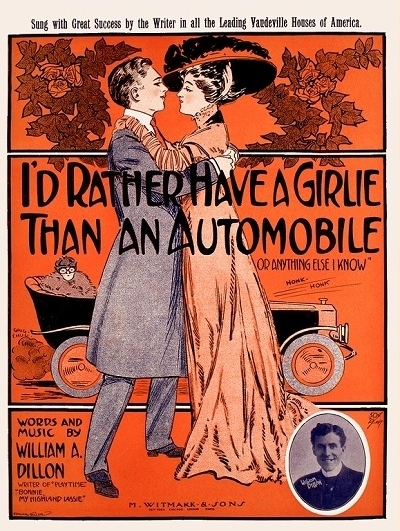
 Given the lack of an 1890 census, it is unclear what Edgar may have been doing in his early twenties, but there is a good chance that he studied art and lithography with one or professionals during that period, even while still living in California. Keller moved to New York City in the late 1890s. While later one-paragraph biographies stated that he "turned to art in 1907," the 1900 enumeration both belies that and potentially explains his training through immersion. He was living in Manhattan with his bride, Nell Adams Clark, whom he had married in 1897, and was clearly listed as an artist. In that same building at 939 Eighth Avenue near the intersection of 56th Street, there were several artists residing there as well, consituting an artist's colony of sorts. It was also a mere two blocks away from the Art Students League of New York, which had been founded in 1875. So it is clear that Edgar was immersed in the artist's culture of New York, and Nell possibly went along for the ride, as she eventually took the craft up as well.
Edgar became versed in several different mediums, including etching, sculpting, oil and watercolor, and illustration. While in training to create his own style, and before he was widely exhibited, he went into the field of both book and sheet music illustration to provide a revenue stream. Some of his earliest work appeared in 1899 and 1900 for a couple of publishers, including Harry Von Tilzer. Then from mid-1900 forward Keller was employed by M. Witmark & Sons publications, and his fame spread from there. The Music Trade Review of July 6, 1901 notes that "Edgar Keller is permanently employed by [Witmark] and puts in his best work in this line." He would do cover work for Witmark more or less exclusively over the next decade. At 42 years of age, Edgar was profiled in the March 14, 1908, edition of the Music Trade Review: When it is taken into consideration that M. Witmark & Sons publish a countless number of songs every year, and that of these some 90 per cent have color title pages, some idea may be gained of the amount of work which Edgar Keller accomplishes every twelve months. Yet he is never at a loss for an original idea. Year in and year out he has designed titles exclusively for Messrs. Witmark, who are always sure that Keller has something novel in reserve. Possessed of wonder natural talent, he has all the qualities which go to make the artist. His technical knowledge was acquired in the West, and the pride he takes in evolving some original form of lettering is only in line with his thoroughness in everything he attempts. Those of his numerous friends who visit his charming little studio uptown know that as a painter in oils he has done his best work. Personally he is a quiet reserved man with a high forehead and a finely cut boyish face. Very rare, indeed, does he express himself on any subject, but when he does offer an opinion it is always well worth listening to. In addition to his work in sheet music, Keller illustrated some children's books, and created art and some verse for the New York Dramatic Mirror, an entertainment-related newspaper. By the early 1910s, if not earlier, both his oil landscapes and portraits were enjoying exhibitions in galleries and other places of prominence. Edgar managed to capture motion and light effectively, sometimes using very rough brush strokes, evoking more of a mood or ambience than realistically accurate renditions of his subjects. Although his music and magazine illustrations did not always have the same depth as his oils, they were still varied and appealing, usually including customized text that complemented the subject.
It appears that with his growing reputation in oils and exhibitions and commissions, Edgar possibly found sheet music illustration either less appealing or too time consuming, and after 1911 he was more or less out of the field. There are some covers brought into question that show up into the late 1910s issued by publishers other than Witmark with the Keller name on them. Some were provided by the artist on rare occasions (such as Laddie Boy), but it is uncertain if he was responsible for a few of them lacking his first name. The most evident reason for the sudden halt of covers is that Edgar became involved with Bison Film Company under Thomas Ince around 1912, and given a role as a technical and artistic advisor on Westerns and Civil War films. He was also employed as a set designer or background scene painter, among other duties, for a couple of months. However, in short order Keller became an actor, ultimately appearing in around two dozen silent shorts and features from 1912 to 1926, much of it with director Francis Ford. Edgar even tried his hand at directing The Yellow Girl in 1916. This meant travel back west as well, and it is probable that the Kellers were in San Diego, California, during the mid-1910s, then in Los Angeles through 1917. However, by 1918, Edgar was re-established in Manhattan, where the 1920 enumeration showed him running his own art studio.
In 1921, Keller spent a great deal of time in the Binghamton, New York, area, creating landscapes. One of them titled "The Black Pearl" received honors and a prominent exhibit. It showed "a hole in the ice on the Chenango River with the dark outlines of Mount Prospect and buildings on the far bank of the river, all casting an iridescent glow into the pool of dark water." Edgar had reportedly driven by the area and found it to be interesting enough to drop anchor for a while. In the mid-1920s, Edgar and Nell relocated to northern California, then spent some time in Portland, Oregon, where they were located for the 1930 census, both of them now working as artists in their own studio.
What was not revealed in the 1930 record was that Edgar, now nearly 63, was ill. Although the nature of his malady was not made known, some indications from scant records imply that it was either cancer or heart disease. Later in 1930 the couple went down to Hollywood, California, possibly to gain some work with the motion picture trade. However, Edgar became increasingly ill, and finally passed on in early 1932 at 64 years of age. He is buried in Forest Lawn Cemetery in Glendale, California. Nell survived him another 33 years, growing a reputation as a fine artist in her own right.
| ||||||

Edward H. Pfeiffer  | ||||||
Edward Pfeiffer was born in New York City in August, 1868 to a German immigrant father Henry Pfeiffer and New York native mother Mary York. Some sources indicate a birth year of 1869, but the 1870 and 1880 census records suggest the earlier year. Edward was familiar with art production at a young age since his father reportedly worked as a professional engraver, although Henry was listed also as a tailor. Edward had two older siblings, including Emily (1859) and Julius (1862). According to a brief biography assembled by his granddaughter, Ann M. Pfeiffer Latella, the young man showed a predilection and interest for art at an early age, probably due to Henry's creative influence. In the 1880 census the family is shown living in Manhattan with Henry working as a tailor and Emily as a dressmaker.
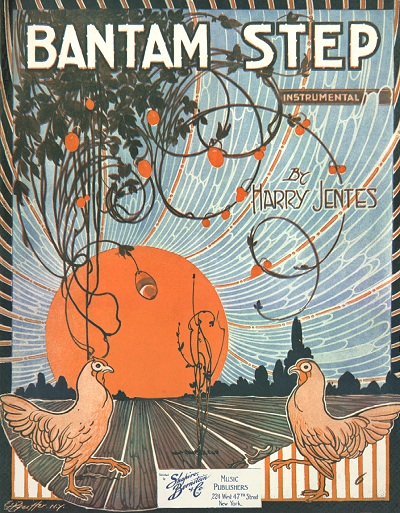
 Edward dabbled in costume jewelry design and some illustration work for publications such as magazines and newspapers, but is best known for his often stunning sheet music cover art, in part because his signature appears on it more often than the other works. At some point in his youth he suffered a leg injury that resulted in a lifelong limp, and the eventual onset of osteomyelitis that contributed to his death in 1932. His pain was such that he designed his own orthotic device to help him walk more comfortably. In the 1900 census, married by this time to Fannie McCracken, he was listed as a designer. Edward Pfeiffer Jr. (Ann Peiffer's father) was added to the family around 1901. Before 1910 Edward Sr. was showing up in Manhattan directories and, and ultimately in the 1910 census as an illustrator with his own studio. Fannie and Edward Jr. were still in the home, but she would soon leave and their son would be largely raised by his grandmother Mary.
Less known about Pfeiffer was his work as a community activist and writer. He contributed articles to various publications, usually about a cause. One example is Making Your Neighborhood Safe for Democracy in a 1919 edition of The Outlook. In his role as the Publicity Secretary for the Central Mercantile Association and later the Executive Secretary of the Chelsea Neighborhood Association, he wrote about a boy's home in Chelsea, a community on the west side of Manhattan. In 1915 he had made a case for creating a modern public school for the children in the neighborhood on the site of some older buildings that could be torn down for the new facility, stating that: "Each of the three old buildings was built prior to 1869... Not one is fireproof or partially so. Eighty per cent of Chelsea's classrooms are crowded beyond their legal capacity. Wardrobe and drinking facilities are inadequate and toilet facilities barbaric. Since the sites of the old public schools are valued by the city's real estate bureau at $600,000 and the proposed new school would cost only $434,000, by vacating these outworn buildings and selling the sites $166,000 would be realized for other school purposes." Pfeiffer was also part of the Chelsea Fresh Air Society which secured "outings and vacations for the need poor of Chelsea District." His name was found on the boards of other charities as well. By 1920 Edward showed as divorced from Fannie, but still working as a commercial artist. As of the early 1930s Edward was infirmed and in managed care, partly due to his earlier leg injury, where he eventually passed on in early 1932 at age 63.
Edward Pfeiffer's first covers date back to 1892, and his volume of work spans over 100 publishers, indicating that his reputation as a freelance artist was likely considerable. The Pfeiffer signature varied in scope from the simple EHP to Fifer to the official sounding Pfeiffer Illustrating Co. However, the majority of his works featured the unique E.H. Pfeiffer N.Y. script, which is as recognizable to collectors as the Disney signature is to children of all ages. While many of his works reflect some representation of the title of the piece they adorn, he was particularly gifted with drawing floral motifs and attractive women, exercising careful consideration for near-photo realistic shading. Pfeiffer was also an early advocate of what became the Art Deco school of art by the late 1920s. Of particular favorites listed here are the highly stylized Bantam Step and three different versions of Wild Cherries. | ||||||

André De Takacs  | |||||||
This unique illustrator and sometime composer was born in Hungary in 1880. His Hungarian father, Andrew De Takacs, who may also have been an artist, was a Hungarian Count. His mother was Helena Therese Chevalier (Bodnar) De Takacs. Andréa immigrated to America from Budapest, arriving June 11, 1901 on the Patricia from Hamburg, Germany. He soon became established as an artist in New York, although he had settled in nearby Hackensack, then Tenafly, New Jersey.
André, as he then referred to himself, started on a path that left a fascinating legacy of artwork,
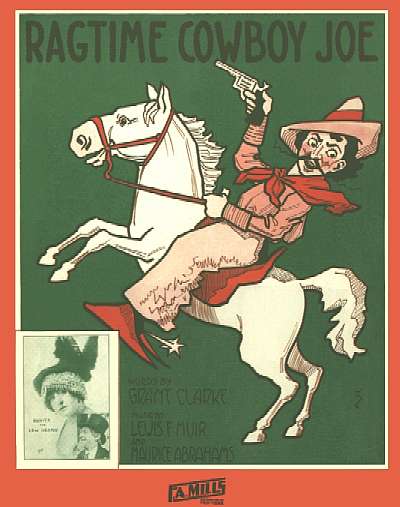
 Two of André's songs included Silent Wooing and When Bessie Met the Bobby of Her Dreams was dedicated to his wife, Elizabeth "Bessie" Schenkel of Tenafly, New Jersey. She also posed for the cover art. André married her on November 20, 1902, just 17 months after arriving in the United States. Bessie was the granddaughter of locally famous violinist Leonard Schenkel who owned the Schenkel Inn in Tenafly, which her parents later ran as the Clinton Inn. She was used as a model for his covers from time to time. In a historical book on Tenafly by Eva Browning Sisson, she recounts the day that the electric trolley line first ran there in 1907. André was present at the inn which held a dinner in honor of the event, and he quickly sketched a drawing of the trolley and surrounding area, which was auctioned off for $20 to benefit the local fire department.
The De Takacs and Schenkel families moved over the next couple of years, and are shown in the 1910 census living with their two daughters Edythe H. (1905) and Bessie Elizabeth (1906), along with Bessie's recently widowed mother and her siblings in Palisades, New Jersey.
There are indications that André may have been involved in the New York motion picture industry, perhaps as a set or art designer. He was known to have worked for Universal Film Company (predecessor to Universal Pictures) from 1916 to 1918. He lists them on his September 1918 draft record, indicating that he was working as an artist. During this period André would also refer to himself as "count" at least once in one novel that he illustrated. His unusual signature was modified several times during his career.
André De Takacs died suddenly on August 23, 1919 at the age of 39, his sad demise reportedly the result of a heart attack in a New York City taxicab en route to a hospital. The funeral notice in the New York Herald had an open invitation to "Members of the American Motion Picture Association" to attend. Bessie worked for several years as a telephone operator but had some financial troubles throughout the next several years. She followed André in 1927 by her own hand, committing suicide by ingesting mercury. Both are buried in Englewood, New Jersey. Their daughter Edythe (De Takacs) Jepsen became an artist in her own right, and was married to one as well, Paul Hilbert Jepsen. She lived into the 21st century, dying at age 101 in 2006.
De Takacs used lots of bold coloring in his work, such as in My Pony Boy, and was able to create both realistic images as well as pleasingly abstract ones. He was quite versatile with the "fade-away" technique, where the clothing or other portions of a subject is of the same color or pattern as the background, making the relevant portions stand out more while the rest of the figure fades into the background. View She Used to Be the Slowest Girl in Town and Somebody Else is Getting It for vivid examples of this technique. Many thanks for additional information and verification go to Andrea Ellis who was named after her great grandfather, as well as Keith Emmons of HulaPages.Com. The last few years have been a voyage of discovery for her family as well in regards to André De Takacs' artistic legacy. | |||||||

Charles Etherington  | ||||||
There are a group of signed artists in the sheet music world that, although they had a signature, they are considered to be "Mystery Illustrators" since virtually nothing is known about them outside of their printed artwork. Hopefully this entry will help to demystify to some degree the identity of the person behind the creative covers of the 1900s to 1920s drawn by the artist who signed them simply "Etherington." As with many such figures, information is scant, but it still gives a little more background than has previously been known on this illustrator.
Charles Arthur Etherington was born in late 1880 in Hartford, Connecticut to machinist Charles Allison Etherington and his bride Carrie Cooper of Springfield, Massachusetts. He would soon be joined by one sibling, Howard W., in January of 1882. By that time, the elder Charles was listed in Hartford directories as an engraver at a printing company, and would soon be considered an artist.
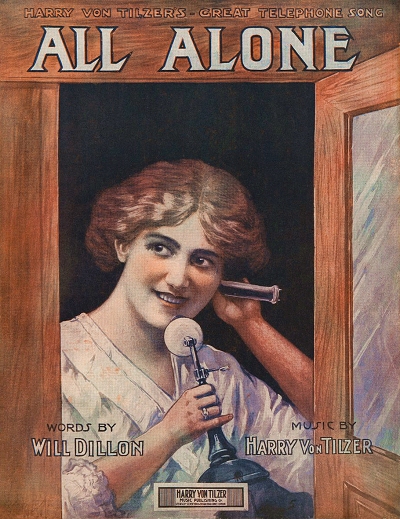
 At some point during the next few years C. Arthur went into the family business of art and engraving, possibly trained by his father among others. Around 1905 he migrated to New York City, and his talent soon got him work in advertising and the recently burgeoning field of sheet music covers. His first work was likely as an independent contractor, providing art for the music publishing houses of Gus Edwards and Harry Von Tilzer in 1906 and 1907. However, by 1908 his client base had expanded. By then he was working for the printing firm of Teller, Sons & Dorner. Etherington's work was well-regarded, and a 1908 ad in the Music Trade Review placed by music publisher Theo. Bendix touted him as part of a talented pool of composers, lyricists and artists. In addition to Edwards and Von Tilzer, he was also providing work for Joseph Morris, F.B. Haviland, Joseph W. Stern and Ted Snyder. A March 14, 1908, article in the Music Trade Review by fellow artist Gene Buck on the "Evolution of the Title Page" mentioned Charles in passing, putting him in good company: Let it not be supposed that the artist alone is responsible for the vast improvement which is apparent in the production of the modern title page. I think that I am safe in saying that ten years ago Edgar Keller was just as talented an artist as he is to-day—not as finished perhaps—but the wonderful creative genius which he has displayed for years in designing the Witmark title pages must have been just as apparent a decade ago. Again, take [William and Frederick] Starmer, [Charles] Etherington and [John] Frew, who like myself are "free lances," designing for anybody who wishes to engage our services; their versatility has surely not come to light in a day. The question is naturally asked them, "to what source is due the marvelous artistic strides made in the modern title page?" and the answer lies in the fact that the credit is largely due to the improvement in mechanical production. Given the often challenging nature of multi-color lithography, it was likely a double-edged sword that newer methods eschewing the old lithography stones both made the cover artists' work easier, while at the same time offering new opportunities for artists with less skill in these methods to enter the field. With perhaps 12 primary and another dozen or more secondary artists working in New York City music publishing by 1910, the roster was not exactly crowded, which helped Etherington and his handful of peers to stand out. He was certainly prolific, turning out forty or more covers a year from 1908 to 1911. And then, the flow stopped abruptly.
Charles had married Louise Filler in 1906 in Manhattan, her second marriage to his first. Eight years his senior, her reported age changed several times over the next two decades, including when she was wed to Charles. The 1910 census, taken in Manhattan, showed that she had lost all six of her children, likely in infancy or at birth. That same record showed Charles as a lithographer and artist. Yet within two years, his prolific flow of sheet music covers would all but stop. There is no clear reason for this, but perhaps he decided to focus on advertising art or book illustration, or even magazines. The 1915 New York census still showed him as working in art and lithography, and his 1918 draft record listed him in the same field, working for what looks like the Alphw Lithography Company on 9th Avenue. It also described the artist as being 6'2" with black hair. By 1920 the couple had temporarily relocated to Cleveland, Ohio, residing with Dr. Alfred Bailey and his wife, who may have been a relation of some sort. Again, Charles showed his occupation as commerical artist for the enumeration, but pinning down his extant work from this period was difficult.
The Etheringtons were back in New York fairly soon, found living in Nassau on Long Island in 1920s directories and the 1925 New York State census. However, at some point prior to 1930, they had relocated to Chicago, Illinois, found there at the start of the Great Depression. From this point on there is largely speculation as to where his life went. The Depression was hard on many artists, with only a few of the best surviving. It appears that during this time Louise dropped out of the picture, either due to death or divorce, and Charles moved to Lyndhurst, Ohio, to reside with his brother Howard, who was working as a trash collector. While he was not found in the 1940 census, he was noted in a couple of mentions in newspapers as working for the Works Progress Administration (WPA), one of Franklin Delano Roosevelt's largest New Deal programs, as an art supervisor. Charles' 1942 draft record showed him as having a crippled right arm, the cause of which was not known, but which may have inhibited his direct work in art over the prior decade, thus his WPA role. After World War II, Abbie passed on, and Charles went to Lyndhurst, Ohio, to stay with his brother Howard for a time. He was found there for the 1950 enumeration as a lithographer and "makers [sic] of posters." Charles subsequently relocated to Miami, Florida, where he died in March of 1960 at age 79.
On his sheet music covers, Etherington showed versatility and consistency, but not all that much uniqueness in comparison to some of his peers. The work was solid, and encompassed several different styles during his six year run, using a palette of two to three colors for the most part. His human figures were well-rendered, particularly on sentimental pieces, but lacked whimsy in some cases. Overall, C.A. Etherington was a capable and prolific artist with solid skills, and should be regarded as one of the major contributors to the look of sheet music, part of the appeal that led to sales, during the middle of the ragtime era. | ||||||

Gene Buck  | ||||||
Eugene Buck (possibly Jean in his early years) was born in 1884 in Detroit, Michigan to George Buck and Catherine McCarthy. He had two other brothers, including Charles A. (7/18/1883) and George W. (1889). Gene was, as some have called it, a triple or quadruple threat, known nearly as well as a musician, lyricist, composer and producer as he was for his cover art contributions.
Eugene's father was an inventor, but he died when the boy was around nine years old, leaving his family nearly destitute. Catherine managed to keep them in a home in Detroit and made sure her sons got a proper education in a parochial school, and two years at a Jesuit college for Gene.

 In early 1907 Gene temporarily lost his sight due to ulcers on his retinas, and was unable to work for several months. After three to four months his sight returned sufficiently enough for him to continue. He relocated to New York City, arriving with only $13.50 in his pocket and no firm position. It did not take him long to find work again as a free-lance cover artist, even making more contributions to his old employer. Gene took a studio next door to artist James Montgomery Flagg, who would soon be famous for the Uncle Sam "I Want You" poster. In addition to covers and paintings he started writing jokes and verses for comic weeklies. The bulk of his 5000 cover illustrations range from 1904 to 1914, a time when he started experiencing more permanent vision problems, making any continuation of drawing difficult at best. The 1910 census shows him in Manhattan as a "designer" in the music field, but he was starting a career transition. Having more or less abandoned Henrietta when he moved, she sued for divorce based on non-support and cruelty, which was granted in March 1909.
Starting in 1910 Buck tried his hand at composing. Many of his earliest songs contributions were as a lyricist to the music of Dave Stamper, the accompanist at that time for Nora Bayes and Jack Norworth, appear on a series of Edison Diamond Discs from the early to mid-1910s. Gene was quite active in the New York music scene and mingled with stars of stage and screen. In 1912 he was engaged by Oscar Hammerstein to do set designs for singer Lillian Lorraine, and also directed her act, which included his co-composition Daddy Has a Sweetheart and Mother is Her Name. Originally intended for her performance in the Ziegfeld Follies of 1911, the song was rejected as the wrong material for Miss Lorraine. She left the Follies a few weeks later, and Hammerstein engaged her as well as Gene to help with her appearances in his show. Lorraine and the song subsequently became a hit, as did the follow-up, Some Boy. Gene also wrote with composers Victor Herbert and Rudolph Friml. He was also one of the founding members of ASCAP in 1914.
Buck spent nearly seventeen years in the employ of Florenz Ziegfeld contributing compositions and set design for the famous Ziegfeld Follies, and even doing some directing as well. His 1918 draft registration showed him as a playwright with Ziegfeld working at the New Amsterdam Theatre. As Ziegfeld's male talent scout he was responsible for either discovering or engaging the services of stars such as Ed Wynn, Eddie Cantor, Will Rogers, W.C. Fields and artist Joe Frisco. He was said to be most proud of acquiring set designer Josef Urban, a European who had been stranded when his company folded. Even though he had no English skills when hired, he became an instrumental member of the Follies, helping design and build many stunning sets. He even decorated the Buck's home in Great Neck. Gene was also responsible for originating the combination restaurant and show on the roof of the New Amsterdam, which became known as the Midnight Frolics, ultimately producing 17 editions of the revue. In 1917 he co-wrote the show Zig Zag for the London Hippodrome. In early October of 1919, Gene married again, this time to actress Helen Falconer, with whom he would remain for life.
Buck continued composing into the 1920s and was the President of ASCAP (American Society of Composers and Publishers) from 1924 to 1941, playing a large role in the licensed use of music on radio. He also was known to have kept some black composers from direct involvement in ASCAP, and was admittedly surprised to find that there were objections to this mode of thinking. Buck helped ASCAP to win a major music protection case in front of the Supreme Court in 1931. During much of this time the Buck family lived in Kensington, Nassau County, New York, then in Great Neck on Long Island. The 1930 census showed Gene, his wife Helen, and their two sons, Eugene Falconer "Gene" (1/1925) and George William (12/1925), in Kensington, with Gene listed as a theatrical producer. Also in the house were his younger brother George, and Helen's two sisters.
In 1936 Gene and ASCAP were up in arms about proposed changes to 1909 copyright laws which, in his words, would legalize music piracy by broadcasters, hotel operators and the film industry. He already had offered some choice words for radio, saying that it could "kill a popular song" in just six weeks. The lobby behind the Duffy bill called ASCAP a group of "racketeers." At issue was the removal of a damage clause and limit royalties to songwriters. Buck was passionate to the cause, introducing some of the "racketeers" at a press conference, including George Gershwin, Rudy Vallee and Ethelbert Nevin. He was further supported Deems Taylor and Oley Speaks, and publishers Carl Fischer, G. Schirmer and Irving Berlin. Florida and Washington state laws were used as a challenge to the ASCAP case, stating that the licensing was illegal. This contest ultimately went through several appeals to the Supreme Court in 1939, and ASCAP prevailed for the moment. This was followed by a challenged from N.A.B., the National Association of Broadcasters, one of the original sponsors of the Duffy bill. The Buck family was seen on a cruise passenger list in 1936 sailing from San Francisco through the Panama Canal. He was also heavily involved in ASCAP 25th anniversary concerts at two World's Fair locations in both New York and San Francisco in 1940. For the enumeration that same year taken in Kensington, he listed himself as an author. His brother George and sisters-in-law were still lodging with the family as well.
Buck tried to buck BMI and their licensing practices in front of Congress in 1940 and 1941. On February 22, 1940, while vacationing in Phoenix, Arizona, he was arrested on a Montana warrant that charged attempted extortion. This came from the demand by Buck and ASCAP that certain radio stations pay fees for the use of music over which the organization claimed control. He claimed that the arrest was part of a "smearing campaign," thus the arrest on a Federal holiday, and was released on $10,000 bond. The suit brought by the state's attorney in Montana alleged that ASCAP was threatening to pull the licenses of radio stations and theaters that were not making substantial payments for those licenses. In turn, ASCAP was fined by the courts for $35,250. While the overall charges were later reduced, when ASCAP was threatened with litigation claiming them to be a monopoly in 1941, Gene consented to a compromise, and then stepped down from his leadership role in early 1942 after seventeen years.
Despite the occasional negative press, Buck was later remembered in his ASCAP role as "the greatest exterminator of piracy since Decatur," referring to the famed 19th Century naval officer Stephen Decatur. In 1940 he received the Henry Hadley Medal from the National Association of American Composers and Conductors for his efforts in advancing and protecting American music. He also became the president of the Catholic Actors Guild, a position he held through the end of his life. He was also a lifelong member of the board of directors of ASCAP. In his long career Gene was reported have had produced as many as 5000 covers, although this includes arranging photographic as well as text-based covers. He also contributed to over 500 songs. The 1950 enumeration taken in Kensington near Great Neck showed Gen and Helen hosting two of her sisters as well as Gene, Jr., and the elder Buck was listed this time as an author of "professional theatricals." Gene died in Great Neck in February 1957 after an illness of two weeks. His funeral rites were presided over by former president Herbert Hoover.
Notable in Buck's style is the use of minimal color palettes, often leaving many elements of the cover clear or showing a single color that would define the cover. The people were consistently drawn with succinct expressions, and the artistic elements when they appeared were well-defined although simply colored and logically patterned. Many of his covers do not bear his signature, but his distinct lettering technique on the Remick issues certainly help give them away. | ||||||

Joseph Hirt  | ||||||
Joseph Hirt was one of those singularly talented "company men" who while working for other lithographers managed to have his work signed, an honor most often reserved for top artists in a firm. Beyond that, virtually nothing was known of him before the research on this article, and even that yielded few clues on this illustrator who still managed to leave his mark on a few landmark covers, and likely on many more that remain uncredited.
Joseph was born in New York City in 1879 to German immigrant tailor Julius Hirt and his Prussian/German bride Dorothea "Dora" Rogowski. The couple had ten other children besides Joseph, including Frederick (3/11/1870) and Bertha (9/15/1872), both born in Prussia, Lena (2/1875), Adolph (1/1877), Wolfgang Julius (1880-1900),
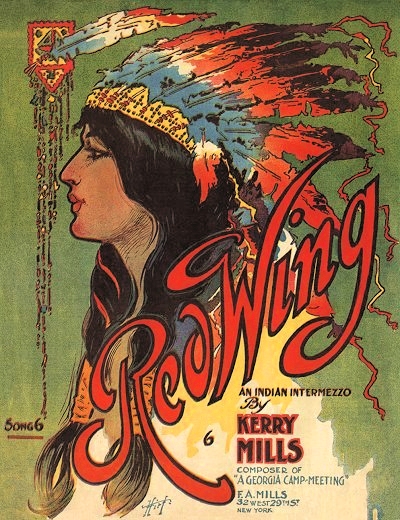
 While no knowledge remains about Joseph's upbringing or training, by the time he was 20 in the 1900 census he listed his career as a pen and ink artist, making it likely that he had either apprenticed or taken classes at an art school. It was over the following decade that Hirt did some of his most lasting and recognizable works for at least two different lithography firms, including Teller, Dorner & Company, and several publishers. Three standouts are the highly recognizable Red Wing, a companion piece titled Sun Bird, and the less well-known but equally stunning Lucia, all of them a tour de force in multiple colors. Very few lithographers created covers of more than two colors plus black, with the exception of the A. Hoen firm who routinely turned out four color prints for composer/publisher E.T. Paull. So the Hirt works do stand out, and in some ways are equal to the Hoen covers. Another of his most widely circulated works was Take Me Out to the Ball Game.
In June 1906, Joseph was married to Adelaide Walsh in Manhattan. For the 1910 enumeration he was shown as still living with some of his siblings and his widowed mother. As it turns out, sadly, he was also widowed, Adelaide having died in March of 1908. The family had moved from lower Manhattan to near Harlem, living at 234 W. 120th Street, and Joseph was listed simply as an artist. The bulk of his cover art, which first appeared in 1901, was done between 1904 and 1911. There were perhaps over 200 completed in that time, with only a few remaining examples appearing between 1912 and 1917. Around 1912 Joseph went into commercial art, working for a few years at Universal Art Service at 1531 Broadway, doing advertising and theater posters. He also married again on November 20, 1911, this time to Florence Baumann. By 1918 he had become a manager at one of the largest New York firms, Morgan Lithography Company at 1600 Broadway. For both his September 12, 1918, draft record and the January, 1920, census, Joseph listed his address as 56 Manhattan Avenue, one block off from Central Park West at 103rd Street, indicating a positive change in fortune. However, the draft card nearest relative contact was his mother, suggesting that his second marriage had ended in divorce. Joseph had switched positions again by 1920, working now as a commercial artist in the film industry. The January 1920 showed that he was residing with his sisters Clara and Elsie.
Now no longer involved in the music business, Joseph stayed with commercial art into the early 1930s. He was married a third time around 1921 to Evelyn Ruth Bond, nearly 20 years his junior, and they had two sons, Joel Alvin (6/30/1922) and Everett Quincy (6/28/1923). In the 1930 census Joseph was listed once more as a manager for a commercial art firm. Joseph, or perhaps Evelyn, also fudged his age to the enumerator by five years in that record. As many positions in advertising evaporated during the Great Depression, Hirt, possibly either retired or downsized, switched to the canvas, and became a fairly reputable painter. Some of his oils are still in circulation in collections decades later. In the 1940 enumeration taken in Queens he listed himself as a commercial artist, even though his output in that realm had diminished. His age listed on that record was 50, a full decade off the mark. On his 1942 draft record, this time showing a somewhat more accurate birth year of 1881, he was listed as a self-employed painter having moved back to Manhattan, living at 1322 6th Avenue. Joseph Hirt died a year later of a stroke at age 63, and was interred at Pinelawn Cemetery in Queens. He was survived by his wife Evelyn and their two sons, also leaving behind an artistic legacy across several different mediums. | ||||||

Nelson Guy Chilberg  | ||||||
Nelson Guy Chilberg had a short but fruitful career as a cover artist, but did little of note that put him into the public eye, so it was difficult to obtain much useful information on his overall life. He was born in Cambridge, Illinois, in the western part of the state near Moline, in April of 1875 to Swedish immigrant Sven Jacob Kihlberg (the original family name) and his Pennsylvania-born wife Margaret R. "Maggie" Lafferty, and had been preceded by an older sister, Mattie Pearl (1872). The 1880 enumeration taken in Cambridge showed Sven to be a clerk in a dime goods store.
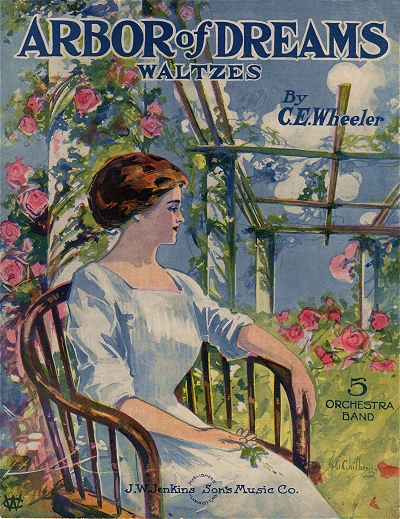
 No information was found on Nelson's schooling, but as with many young men who had an artistic bent, it probably included some courses in drawing and drafting, leaving him equipped to be an illustrator or work in a graphics art firm, many of which covered disciplines from architectural blueprints and renderings to advertising for newspapers and magazines. After his schooling he relocated east to Chicago, Illinois, where there would be any opportunities for work. Among the first drawings Nelson did that were published were some for a book of verse by The Wizard of Oz author L. Frank Baum titled By the Candelabra's Glare, which predated his more famous work by two years, published in 1898. His illustrations were mixed in with some by other notable artists, including Frank Hasenplug, C.J. Costello, and future Oz artist W. W. Denslow. The 1900 enumeration taken in the Hyde Park area of Chicago showed Chilberg to be a draughtsman. He was married to Mabel L. Lewis on February 21, 1901, and their son Guy Lewis was born on July 8, 1906. His sister, Mattie, had died relatively young in October of 1905.
Little of Nelson's work was attributed over the next few years from 1900 to 1905, so probably involved unsigned advertising or commercial projects as per his employer. However, in 1906 he was most likely contracted through his firm to do a cover for a piece of music, A Jolly Old Ride in a Glide, that advertised the Glide automobile manufactured by the Bartholomew Company in Peoria, Illinois. This is the only sheet of Chilberg's found that had a Peoria imprint on it, so was likely produced and printed in Chicago. It seems likely that this either gave Chilberg the initiative to pursue more cover art, or at least got him noticed by other publishers. The majority of known sheet music cover artists at that time were in the New York area, with just a handful in Chicago. The ability to thematically represent a piece of music in a single picture was a desirable commodity in the industry, since in lieu of phonograph recordings or piano rolls, the song demonstrators and tasteful or relevant covers were the best form of advertising.
For the next several years, while still in the employ of another company, Chilberg provided cover art with increasing frequency to Illinois, Wisconsin and Missouri area publishers, including Joseph Flanner of Milwaukee and F.J.A. Forster in Chicago, and surprisingly, given the distance, Charles L. Johnson and Jenkins' Sons Music in Kansas City, Missouri. In addition, he also scored a few covers for New York and Detroit publisher Jerome H. Remick. While Nelson was not terribly prolific in this field, he did create some significant images, all with a fancified N followed by a simple G. Chilberg. Most of them had clear focus, with the title an almost separate entity from the descriptive picture. No matter if they were two, three or four-color images, all had an element of realism, and many of beauty. He was particularly good with crowd scenes and intimate moments. Some of his most colorful works remains Glad Smiles from 1909. The 1910 census showed Nelson working as an artist for a novelty company, which may still have been related to advertising and posters.
Work in the music field started to pick up for Chilberg in the early 1910s, with Forster issuing the most music sporting his images. However, for reasons that were not readily available in the research, he died in Chicago at age 37 on August 8, 1912, leaving behind his wife and son, and a potentially increasing number of memorable sheet music images that would have helped to define the end of the ragtime era and the beginning of the jazz age. He is interred in Cambridge with his parents. | ||||||

H.C. Henrich  | ||||||||
Although New York seemed to dominate the illustated sheet music cover world with its core of talented artists, Chicago had several fine contenders who did laudable work and even beyond. This particular artist, known mostly by his last name of Henrich, actually lived a much separate life after spending a decade in the world of music covers, but left his imprint behind in many Midwest publications. Those who know of his later work may have had no idea about this facet of his career, and the reverse is also true.
Harrison Henrich was born in 1875 in South Bend, Indiana, to store clerk Michael Henrich, a German immigrant who had been "born at sea," and his Indiana native wife, Mary Minerva Crockett. The date of August 4 was what he wrote on his WWI draft record, but some other sources show August 1, so the variance is up for grabs. One other child was born to the couple in 1879, Bessie Irene, but she died at age five.
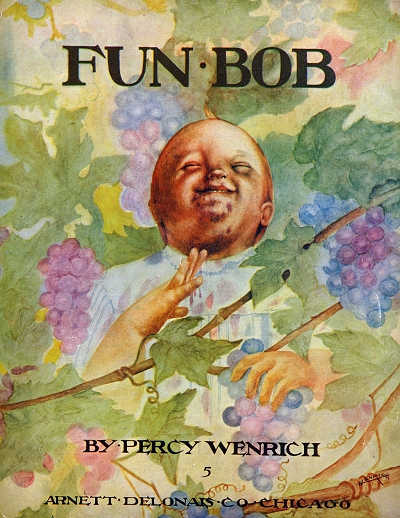
 The 1900 census listed Harrison (going by Harry) as a cartoonist, and by that time he had already done a few sheet music covers, one of them a stereotyped coon song illustration that could fall into the cartoon category. There was nothing solid found to indicate that he was also drawing cartoons for a newspaper or magazine, but that is likely as some satirical cartoons from that era are still extant. Until late 1908, Henrich provided covers for the major Chicago publishers, as well as for Kansas City composer/publisher Charles L. Johnson. His work shows up primarily on works issued by Victor Kremer, Arnett Delonais and F.J.A. Forster. In 1903 Henrich formed his own small corporation with an office in downtown Chicago. By 1907 he was working from the famed Auditorium Building on Michigan Avenue in the tower section, with a shared studio space on the eleventh floor occupied by other Chicago artists. In addition to his sheet music and cartooning, Harrison had been gaining fame even beyond Illinois for his fine oil portraits, most of them of the society women of Chicago, such as Mrs. Marshall Fields, wife of the department store magnate. Eventually, one of his subjects either caught his eye or he caught hers, and it changed his direction markedly.
According to at least some mentions from around 1909, but difficult to confirm, Henrich had a studio of some kind in Vienna, Austria. It was either there, or in Chicago that he met Carolyn Harbaugh Turner. She had recently been widowed by her wealthy husband, three decades her senior, and Harrison, nearly a decade younger than she, painted her portrait. Then he found himself staying in Los Angeles near her home in early 1909, and on March 8 eloped with his rich paramour to the south in San Diego. According to the Los Angeles Herald of March 9, 1909: Claiming the woman who was his "artistic ideal" as his bride, Harrison Crockett Henrich, artist and portrayer of beautiful women, this afternoon wedded Mrs. Carolyn Harbaugh Turner, wealthy widow of Los Angeles… It was to avoid the formalities of a wedding befitting the station of the bride that the trip to San Diego was made and the wedding quietly celebrated. The bride is the widow of the late W. W. D. Turner, known as the Leroi mine king, and beside her handsome home in Chester place, she inherited a fortune estimated at from $3,000,000 to $6,000,000. The groom, it is said, is also possessed of means. The couple will reside in Vienna, where Henrich has his studio, and pass their winters In Los Angeles.
Overcome by a feeling of bashfulness, Henrich left his suit cases and baggage in the room he had been occupying at the Hotel Lankershim in Los Angeles and took out enough wearing apparel in his portfolio to supply his needs while on his wedding trip. At the hotel it is said that he kept constant watch on the elevator, waiting for an opportunity to get out unseen. It was a matter of general comment around the hotel that he was about to wed Mrs. Turner and it is presumed that he feared to pass through the lobby with his baggage, which would indicate that he was intending a trip for some mysterious purpose… Having abandoned the chilly Midwest for sunny California, one of Harrison's first projects was to capture "Types of American Beauties," specifically California Girls, in a series of sepia drawings, which were subsequently exhibited and published in book form before the end of the year.
Harrison Henrich, the Chicago sepia portrait painter, whose studies of Mrs. Marshall Field and other prominent Chicago and New York women have justly brought him no little fame, is at present in Los Angeles and will shortly leave for this city, where he will stay for a few months, and may possibly eventually open a studio. Henrich's work is already well known locally and in the southern part of the state, as he has done work for many well known Californians. His forte is portrait painting, although in eastern circles he is almost as well known for other studies. During his stay here he will in all probability hold a comprehensive exhibition of his portrait work at one of the local galleries. In the end, Harrison remained in Los Angeles for pretty much the remainder of his life. The 1910 census showed him as a portrait artist, and there were some exhibitions of his portraiture in both Los Angeles and New York over the next decade. However, he also seemed to embrace the collective financial status of both himself and Carolyn, and curiously, for the final 1918 draft call in September, listed himself as a rancher of all things. They lived comfortably in a large white mansion at 990 S. Magnolia Avenue in Los Angeles, which was dubbed as the "White Elephant." Rancher or not, Harrison was hardly done with his notable work. A profile of the artist was included in the long-running Overland Monthly in their May, 1919 edition: HARRISON CROCKETT HENRICH, the noted artist of Chicago, New York and Paris [!]… is a disciple of Sepia Art. Every touch Henrich lays on canvas is unerringly drawn, every thought he conceives is beautiful. The result is that he gives us some of the most delicate types of American beauty that have yet been produced…
There is an individuality about Henrich's work that is most appealing, it is so human. He knows how to place his forms correctly and he uses light and shade tenderly. The art-gift is an inherent quality awaiting the time for expression and development… If the house he builds is a house of cards you know it. But if it be hewn out of stone and enduringly put together, you know that the builder was a master of his craft.
… Ruskin tells us that "Greek Art and all other art is fine when it makes a man's face as like a man's face as it can." This is a distinctive quality in Henrich's drawings of women. He believes that all human faces should be made as like human faces as it is possible to make them. He has a tremendous energy for work and he follows out his ideals with infinite patience. His hand is strong and firm and he keeps it under absolute control so that at all times it can move with serenity and ease… The 1920 enumeration had his occupation once again as an artist. Carolyn had generously reduced her age by a full decade to match her younger husband's 45. In addition, Harrison's parents were now residing with the couple, but both of them would die within weeks of each other before the year was out.
The 1930 census showed him to be an independent artist, still at work in his fifties, although he claimed to be just 51, and Carolyn 50, a full 15 years off the mark. From the early 1920s Harrison engaged in some real estate spculation, albeit with Carolyn's considerable fortune. Things did not go well in this endeavor, and by the latter part of the decade they were stuck with properties that were not moving, and very little equity to show for it. Things were made even worse by the Great Depression of the 1930s, which further depleted an already shrinking bank account. Carolyn would die at the end of 1933 at age 68. Harrison soon had to vacate the mansion due to ongoing financial duress, and it was purchased by actor Spencer Tracy, who turned it into a school for the deaf. It appears that very little work, if any, was produced by Harrison after this time. The 1940 enumeration showed him lodging in the home of Alma Norris, but with no occupation. Harrison Henrich died impoverished on May 9, 1944, 35 years and one day after his marriage to Carolyn. They are both interred at Valhalla Memorial Park in North Hollywood, California.
Henrich's cover art clearly showed range and character, and some of his work clearly eclipsed that of his New York colleagues. In particular, his covers for Arnett Delonai were rich and colorful, given that the publisher was able to invest in four-color printing. One of his standouts in that regard was Fun Bob by Percy Wenrich, showing a jubilant child in a grape orchard. Indi-Ana is also stunning, with a cutout portrait of a Native American girl against a white background, both poignant and slightly sad. His caricatures of black subjects, such as Topsy and Trixy, and the highly-detailed Watermelon Trust, were less caricature (common for the time) and more about capturing the mood of those depicted. There were also some interesting variations, such as his use of pastel crayons for the cover of Sunshine, or the simple pencil sketch of Sweethearts. Among the details are his realistic use of light and shadow, which is not always present on music covers, considered by many to be outside of the realm of fine art. And yet Henrich's signature usually indicated exactly that - fine art. While not everybody may look for or see his distinctive split signature, his work still gets notice, and even more than a century later is worth a long look than most other covers, a fine legacy to have left for the world. | ||||||||

Walter J. Dittmar  | ||||||
Signing always as W.J. Dittmar, Walter Dittmar was born in 1879 to German immigrant John Frederich Ferdinand Dittmar and his Pennsylvanian wife Mary Schanbacher in Williamsport, Pennsylvania. He was the youngest of five surviving siblings, including Charles Frederick Elmer (1864), Emma A. (8/1866), William (3/1870) and Oliver Ferdinand (6/9/1872). The future artist was a life-long resident of Williamsport. Walter received no formal artistic training other than what was taught in high school, although his father was a woodcarver, which requires some level of artisan skill. In his late teens he was employed as a freelance illustrator with the Grit Publishing Company in Williamsport.
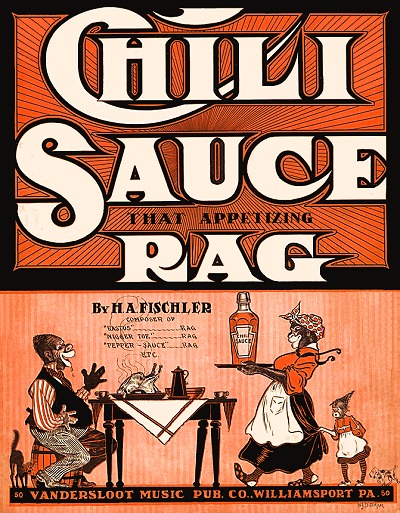
 On April 15, 1903, Walter was married to Daisy Irene Scudder at her parent's home in Williamsport. From 1904-1914 or so Dittmar was the primary artist for the amazingly prolific Vandersloot Music Company. His covers adorned more than 100 music sheets published by the Williamsport company. Walter's parents were charter members of the First United Evangelical Church in Williamsport, and his brother William was a church worker who was in the choir and taught Sunday school. The family was heavily involved in Christian community, which brings up an enigma of sorts.
As was expected at that time, many of the rags and song publications from Vandersloot, as well as other publishers, were steeped in ethnic stereotype. So Dittmar could turn out a beautiful landscape for a sentimental piece one week, plus attractive drawings for the Herald, yet the next week produce some blatantly offensive images for rags that even included Nigger in the title. But accounting for the environment of that era (although not so much in rural Pennsylvania), work is work, and he did it well.
The 1910 census shows Dittmar as an independent artist with his own shop. Daisy had given him two children, Irene (1906) and John (10/1909). Irene's sister was living with the couple, and Walter's mother, sister, and brother William were residing next door. A few years later on his 1918 draft record, Walter's employer was shown as the local Herald Publishing House, which put out Christian materials. Little had changed by 1920 as the census showed that the Dittmar family seemed to all live in the same general block in Williamsport. Walter was still listed as an illustrator, although he eventually also taught art in the Williamsport school system from the 1920s to the 1940s. He further illustrated for a Williamsport-based monthly Christian magazine called the Gospel Herald, and for the Union Gospel Press of Cleveland, Ohio, from the 1910s to the 1960s, listing the latter as his employer on his 1942 draft record. By the time of the 1950 enumeration, taken in Williamsport, Daisy had died, leaving him as a widower, living with his daughter Irene and a granddaughter. Walter was listed as a religious artist, and Irene as his assistant artist. Walter passed on in 1964 at age 85 in Harrisburg, Pennsylvania. His daughter Daisy had carried on the family tradition by teaching art in secondary schools in Williamsport.
Of note in Dittmar's illustrations, which actually had quite a bit of variety between beautiful nature or romantic scenes and outright caricature, was his effectively sparse use of color. While it may have been a directive by Vandersloot in order to keep cover costs down, it was more likely because he was color blind, making management of multiple colors difficult at best. With just one color plus black he was able to create subtle shadings and halftones that filled out many details in a picture, even if tree leaves aren't really pale maroon. He also provided a great consistency for the Vandersloot output, much in the way that Hoen did for E.T. Paull, making the pieces from this publisher just as identifiable without having to look for the logo. Even on covers incorporating photographs Dittmar was able to make artwork out of an otherwise stiff looking band portrait. Many thanks for additional information and verification go to the descendants of W.J. Dittmar, historian Alec Stevens, and the Lycoming County Historical Society. | ||||||

James Dulin  | ||||||
James Dulin was a Kansas City, Missouri native, born October 24, 1883 to James Everett Dulin and his wife Lillian H. Hagerty, both Illinois transplants. He was the oldest of two boys, including his much younger brother Everett V. Dulin (1/1899). James was living in the same place as many fine ragtime composers like Charles N. Daniels and Charles L. Johnson, the latter of for which he eventually created some covers.

 On July 15, 1909, James married Michigan native Adah Dorothy Donaldson, who was also a fine artist working for a Kansas City paper. For the 1910 census Adah was living in a boarding house in Kansas City, but James was not found in the listing, possibly because he had gone out on the road to look for a better work situation. The couple moved to Chicago, Illinois, later that year. Dulin started producing sheet music covers and other art from his own studio in Illinois in late 1910. Dorothy was soon working as a staff artist for the Chicago Tribune. Among her specialties were fashion drawings, for which her reputation would grow into the 1930s. She also contributed some sheet music cover art during her career, including some joint efforst like I Love You Dear. Both of them were utilized by F.J.A. Forster Music in Chicago and Whitney Warner Publishing in Detroit.
Enlisted for service during World War I, James so enjoyed France that after the war he moved his art studio there along with a printing business, and the Dulins spent a lot of time in Europe throughout the 1920s. In 1923, James taught illustration classes for the summer school of the Chicago Academy of Fine Arts. While there he created many fine graphics for a number of French organizations and even engaged in book illustration. Dorothy was engaged in doing paintings and drawings for fairy tale books, a skill that brought great demand for her work. Throughout the decade he maintained a residence in Illinois. Records also show a couple of trips to and from France in the 1920s, and even a 1930 trip to Shanghai, China, so he was also a seasoned traveler. However, on one of those trips it appears that he brought home a different wife, French-born Renée, some 23 years his junior. They subsequently had two children, Francis (1932) and Jacques (1935), both born in Ohio. In 1931 the Dulins re-established themselves permanently in the U.S., obviously having lived in Ohio, and possibly having resided in Springfield, Missouri for a while, where James continued to do music covers and other commercial art through the mid-1950s. His 1942 draft record showed him as employed by the Carl Gorn Printing Company in Chicago. He listed his brother as living in New Jersey and working as an MD.
While James' earlier works referenced Dulin Studios, he later signed his works with a vertical Jamie, sometimes unobtrusively hidden within the image in the manner of Al Hirschfeld. It was reported that as late as the 1950s Dulin was receiving perhaps $25 per cover, and often created many images for one piece to give the publisher something to choose from. He was frustrated with the non-artistic turn that covers had taken, moving to personalities and photographs with only some abstracts surrounding them. James would often not know the names of the pieces he was commissioned to draw for, so would leave nonsense titles in place which the publisher would replace. The family remembers one in particular called Ixio Pontine. Other than payment for the art, he rarely received even a courtesy copy of the sheet, and his original artwork was usually kept by the publisher. Having established himself in Sarasota, Florida in the late 1940s, James joined the faculty of the Ringling School of Art, which was associated with the famous Ringling Brothers Circus family. There he taught drawing and painting. The 1950 enumeration showed James, Renée, and their two sons in Sarasota, with James as instructor at an art school, likely the Barnum organization. James Dulin died in June of 1958 in Sarasota. He is buried in Springfield, Missouri.
In spite of the detail present in much of Dulin's work, his images remain uncluttered and to the point. Color use was kept to a simple palette (easier for printers), and each element had a clear purpose within the image, whether background or foreground. Since many of his later works went unsigned to avoid a particular legal conflict of interpretation or authorship, an accounting of his full body of covers is difficult at best. Many thanks for additional information sent to me by Jacques Dulin of Washington, grandson of James Dulin. | ||||||

Henry Reichard  | ||||||
There is very little professional or family information available on this elusive artist. Henry Reichard (who most often signed his work as H. Reichard) was born in 1862 in Furth, Germany, to woodworker Robert Reichard and his wife Louisa. (The 1900 census shows 1863 as his year of birth, but the 1880 census and his death record both show 1862.) Henry was the second of four children, including Emma (1860), Mary (1864) and Carl (1866).
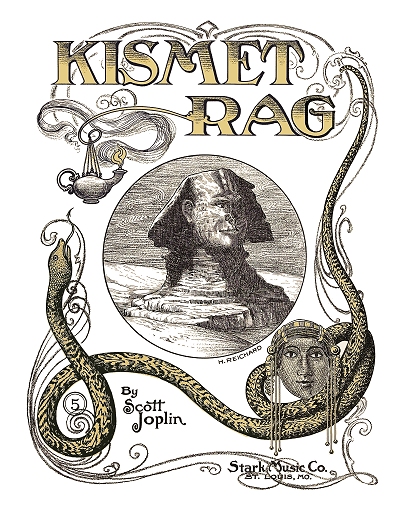
 It is clear that by the time of the 1900 census that Henry was based again in Missouri, living in the Saint Louis suburb of Saint Ferdinand (now part of the city). His occupation in that record was listed as a designer. Reichard's brother was also an artist, and both had works featured in the famous Pan American Exposition held in Buffalo, New York in 1901, site of the assassination of then-President William McKinley. The 1902 Saint Louis city directory shows Henry as the head of his own self-named firm, working in "Art and Advertising." Most of his sheet music covers appear to be from publishers in Saint Louis, including many on featured items in the John Stark catalog, even though John Stark himself was working in New York City during much of that period. Ragtime historian Ed Berlin has suggested that the girl depicted on the Reichard cover of the five Pastime Rags by Artie Matthews is actually John Stark's daughter Eleanor Stark.
Henry worked well with line-shaded motifs, and appeared to be comfortable with either pencil or charcoal in his renderings laced with some watercolor. With little exception there is some form of flora or floral motif in most of his artwork, and a level of fine detail in all of it. Reichard's sheet music drawing career may have been short lived, as all of his covers appear only in the 1910s. Henry was still in Saint Louis 1910 listed in the census as an artist of pictures. Jeanette was still living with Lena and Henry at that time. He opened Reichard's Art Shop within a couple of years, probably an outlet for supplies as well as a studio. He ran the store until at least 1915.
Henry and Lena had moved to Chicago by 1917, and opened a short-lived music store on South Halstead Street, selling pianos and phonographs, and presumably sheet music. As of the January 1920 enumeration Henry was listed as a commercial artist and living in a Chicago boarding house. His status was still that of married, but it was possible that Lena was sick and in a hospital or sanatorium of some kind. She died on October 14, 1920 at Cook County Hospital. Little is known of Henry's career in the 1920s. However, by the time of the 1930 enumeration, he was rooming in Chicago with psychology teacher Elizabeth Carter, possibly his landlady. He was listed in that census as a commercial artist, but in what media is unclear. As Lena was shown as his wife at his time of death in spite of her absence, he evidently never remarried. Henry Reichard died in late 1939 in Chicago, and is buried in Norwood Park Cemetery. Many thanks for some additional information and verification go to David Reichard McCusker, the Great Grandson of Henry Reichard. | ||||||

John Frew  | ||||||
Very little is available on this talented artist whose primary legacy graces a number of large format covers from the early 1900s to around 1914. Frew was born in Ballymena, Ireland, on January 21, 1874, and immigrated to the United States in October 1895, remaining in the country as a non-declared alien resident for some time. He met his wife Molly Elizabeth Leroy in New York and they married on September 12, 1908. The 1910 census showed them residing in Manhattan with John listed as an illustrator. Frew's 1918 draft record listed him as a self-employed artist. For the 1920 enumeration he listed himself as a commercial artist Molly showed no occupation.
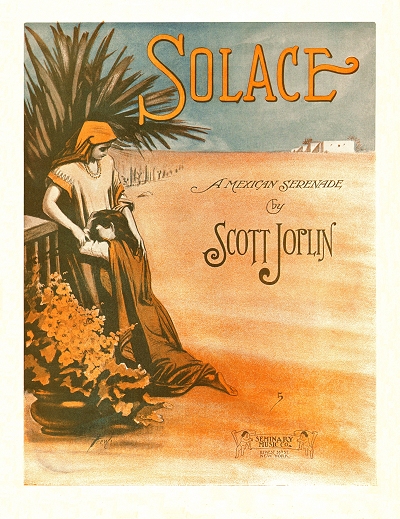
 At one point it appears that Frew may have literally been a "starving artist," as he made the news when going to court in 1919 after his landlord for rent profiteering. This was after the rent for his West 58th Street apartment had jumped in half year from $45 per month to $52.50, then $70. He made it clear that during a previous winter he walked up and down six flights of stairs, understanding that tenants had a choice of heat or a running elevator. Frew further noted that finding any lodging in midtown Manhattan was hard enough, but that such abrupt increases made it unfathomable to either stay or move. His case was made particularly public, and along with a few others eventually prompted the 1920 Emergency Rent Laws in New York state. These demanded a standard of reasonableness for both rates and increases, and was eventually modified into the famous rent control that was the bane of landlords but necessary safeguard for tenants in Manhattan and surrounding New York City.
From 1903 into the late 1930s Frew took multiple trips back to the United Kingdom, likely both to visit family as well as keep his visa current as he retained his Irish citizenship. Molly accompanied him on many of these trips. The couple was found living with John's cousin Victor Stewart and his wife Irene Stewart on Riverside Drive in Manhattan for the 1930 census. Still listed as a resident alien in 1930, he had already filed an intention to become a US citizen in 1928, and was finally granted that privilege in January 1935. In their late fifties by this time, the Frews evidently never had children, or at least none were seen in government records. By 1940, Molly had died, but John was still residing with the Stewarts, and had no occupation listed in the census.
John was able to produce quality artwork on demand, and some of his concepts combine the simple with the intricate. In many cases the subjects would be well rendered with careful shading while the backgrounds were very basic. His work was not as dimensional as other serious artists, but covers such as the comical Dill Pickles Song and the entrancing Solace (done while publisher John Stark was still doing business in New York City) are nonetheless visually stimulating. His most widely circulated work, due in part to the success of the piece within, is the famous Alexander's Ragtime Band song cover. John Frew worked within a limited circle of New York publishers, and reputably suffered from eccentricities that many associated with artistic types, a factor that may have made his working relationships difficult. He also dabbled in comic and magazine/book cover art from the early 1930s through the mid-1940s, including the Astounding Stories line.
The 1950 enumeration, taken at the same address on 109th Street in New York as the 1940 record, presented a conundrum. Frew, now unable to work, was shown as residing with one Ernest Frew (1900) and John Frew, Jr. (1913). As they had not been found in any prior records, and searches of military and other official records could not confirm who they were, it remains a curiosity as to what these two gas station attendants were to John officially. Ernest would have had to been from a marriage or relationship prior to John's marriage to Molly. The association remains suspicious at best, all factors considered. John Frew died in a mental hospital in 1955 at age 81, having exhausted his funds, which could also be linked to those two men claiming to be his sons. Fortunately, much of his engaging work remains with us today in perpetuity thanks to his sheet music covers. | ||||||

Bert Cobb  | ||||||||
Bert Cobb managed to leave a mark on American cartoon and sheet music cover art, as well as fine portraits of canines, while not leaving much of one on public records, making it difficult to obtain very much information on his life. He was born in Chicago, Illinois in 1869 to Ohio native Henry Zenal Cobb and his Illinois wife Sarah Johnson. The family was in the bed-spring business at that time. However, they soon moved to Wilmington, Delaware where Henry expanded into making car springs for carriages and trains. Albert had at least seven siblings, including Henry Zenal (1867), Henry Reid (1871), A. Pullman (1874), Kate (1877), and a brother born in 1880 who died in infancy.

 After being educated in Wilmington at a military school, Bert went to the Philadelphia Academy of Fine Arts in the late 1880s. There he learned etching and cartooning, as well as working with woodcuts and half-tone lithography. It was in cartooning that he got his start, working first at the Kansas City Star, then in Philadelphia around 1898. While there he contributed comic strips to the syndicated McClure's Sunday Section and did occasional work for the Philadelphia Sunday Press By 1900 Bert was residing in New York City and contributing humorous writings and comic caricatures to various papers through syndication, focusing largely on the New York Morning Telegraph Sunday edition. The left-handed artist also illustrated a few small books that might be considered the pulp fiction of their time.
Bert branched out and took on a bit of sheet music cover art jobs during this period. Most of his work covers 1900 to 1903, supporting publishers E.T. Paull and Howley, Haviland & Dresser. He is now largely known for his early "coon song" caricature covers for H, H & D, but Bert tackled some fine art projects as well. This includes the simple but elegant Arizona, Champagne, Broken Ties and Where the Orange Blossoms Bloom for Paull. Even though they were largely monochromatic, an unusual move for the publisher who was known for using brilliant multi-color chromolithographic covers, Bert's drawings showed amazing detail and depth. His covers were rarely seen after 1903, but a couple appear as late as 1911 under the Jerome H. Remick logo.
On February 26, 1901, Bert was married to Louise Ann McMurray in Manhattan. The following year Cobb launched a comic art and literature-based periodical called Pen and Ink which included contributions from other cartoonists, along with fellow illustrators Frank Butler and Reo Bennett. It also included contributions from Palmer Cox who was known for his Brownies characters. It did not last very long, folding within a year. The 1905 New York State census showed Bert and Louise living on 5th Avenue in Manhattan, with Bert working as an artist.
Over the next several years, Cobb's cartooning work was seen in the political humor magazine Puck, as well as in the New York Globe. He had a brief court battle with the American Newspaper Syndicate in Washington, DC in 1905, winning a suit for an account due of $75 for his work. Around 1906 Cobb moved to Boston and his strips were found in the Boston Herald and the Boston Post. A 1907 syndicated strip was about a clumsy fellow named Stumble-Toe Joe. One that appeared in the Herald from 1907 to 1908 was Ambitious Teddy about a boy who was at times a bit zealous. Another good humorous example of mischievous children was a strip that ran in 1911 called Meddlesome Millie about a little girl that constantly got into trouble.
During the mid-1910s Cobb became the official cartoonist for the Republican National Committee, responsible for all of the cartoons issued in conjunction with the presidential campaign of William Howard Taft. During World War I (the "Great War"), he drew a number of Liberty Loan posters in support of bonds to fund the effort. Before 1916 he had moved back to New York City where he became a member of the New York Press Club and the New York Illustrator's Club. There he did some artwork for an early rendition of Life Magazine (not the same one that started in the 1930s). Among his more interesting enterprises that did not quite launch was the intent to make animated cartoons in Rochester, New York, as noted in a 1917 article in the Rochester Democrat. Mr. Cobb had not been here three days, he said yesterday afternoon when he realized that he might help in putting the city on the motion picture map, and incidentally, himself on the financial map. … Animated cartoons—pen and ink drawings that are as lifelike as, and funnier than, genuine motiong pictures—will be produced by the artist in a way that never before has been attempted. Already Mr. Cobb has been obliged to hire assistants because of the amount of work he is doing. He has two cartoonists in view now, and later, with larger quarters, he will have an office and studio staff of about fifteen persons. His reasons for picking Rochester were due to it being the home of photographic film manufacturer Eastman Kodak. The methodology he planned to use was a stop-motion technique with cutouts. At least one catoon of a dog, Chubby's Capers, was exhibited in Rochester in March, 1917. None of these cartoons are known to exist,
Around 1922 Bert married again, this time to German immigrant Elizabeth "Lisa" Balsie. The couple lived in the Bronx in upper New York City, but did not have children. That same year, he created a notable series of cartoons honoring "Captains of the Automobile Industry," which appeared in newspapers through the United States and Canada. Cobb changed directions in his drawing career in the early 1920s, and starting in 1923 he devoted himself mostly to dry point etchings of famous dogs. Many of them were commissioned by the owners of award winning canines, and his reputation grew to the point where he was almost constantly in demand. This further resulted in multiple coast to coast gallery exhibits from the mid-1920s to the early 1930s. The most prestigious of these showings were held at the Kraushaar Galleries in New York. Cobb also compiled at least two books of his artwork published in the early 1930s, Portraits of Dogs and Hunting Dogs, in addition to doing fine illustrations for many others. He was also the unofficial cartoonist for the Republican National Committee.
In the 1930 census Bert and Elizabeth were still living in the Bronx, with Bert listed as an artist. They moved to a Cleveland Drive address in Harmon, New York, within a couple of years. In mid-March 1936 Cobb was admitted to Grasslands Hospital in nearby Valhalla with pneumonia, dying on the morning of April 2 after a ten day illness at age 66. His ashes were interred at the Cobb family vault in Wilmington, Delaware, on April 5. From that point forward, Lisa was the keeper of his memory, a veritable curator of many of his sketches. Bert's original art works, particularly his dogs, still command prices as high as the four digit range nearly a century later. | ||||||||

Leland Morgan   | ||||||
Named after the famous business tycoon, railroad investor and California Senator [leaving behind a nefarious reputation], Leland Stanford Morgan would eventually become known for his artworks and teaching in the field, but his initial story did not point in that direction. He was born in 1886 California to lumber yard clerk Alvin Nelson Morgan and his wife Margaret Ann Carberry (some sources show Donnion as her last name). Although four other siblings were born during the 1880s, only one other survived, his brother George Nelson (1/22/1885). It is not clear why Alvin left Illinois for the west in the early 1880s, but even thirty years after the famed California Gold Rush had subsided, there was still plenty of opportunity for enterprising individuals. Throughout the 1880s and 1890s, San Francisco directories showed Alvin working as a clerk, yardman, and even foreman of a lumber yard, as did the 1900 census taken in the city.
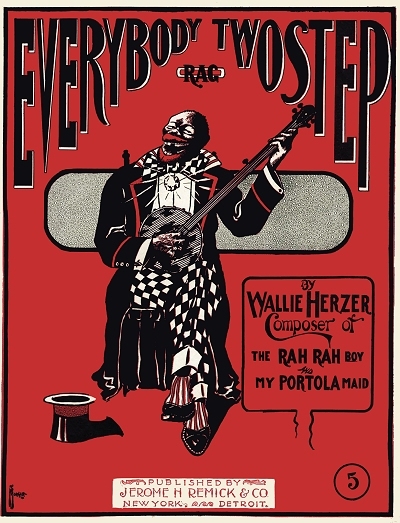
 San Francisco directories from 1905 to 1909, and the 1910 Federal enumeration, all indicated that Leland was working as a bookkeeper or clerk at the insurance firm of Christensen and Goodwin. Still living with his parents and brother, it appears he soon had a change of heart in terms of pursuing his skill set, and in the 1910 San Francisco directory published mid-year, Morgan was listed as a cartoonist. The following year's directory elevated him to the status of artist. It is unclear what publications he may have been contributing to at the time, but there were plenty of newspapers and even a few magazines based in the Bay Area with which he may have done business. Around 1912 Leland migrated across the Bay, settling in Oakland, California, now working as an illustrator. In addition to the occasional book, he started providing sheet music covers in the early 1910s, largely to local publishers, although a couple of them managed to make it to New York via acquisition. The most widely-circulated of those graced the covers of two compositions by Wallie Herzer, a sometimes-composer who was also working in insurance and, in fact, at the same firm as Morgan. When the self-published The Rah-Rah Boy and Everybody Two-Step gained some circulation and the latter piece was released on records, they were both purchased by New York publisher Jerome H. Remick in 1911, including the plates and original cover. This may have encouraged Leland to continue in this field, in addition to his other illustrative pursuits.
During the 1910s Morgan contributed covers to many Bay Area publishers, the most frequent client being Buell Music, a vanity firm run by composer Joseph Buell Carey. However, he also managed some fine work for piano manufacturer and music store Sherman, Clay & Company, Daniels and Wilson run by veteran composer Charles Neil Daniels, and Nat Goldstein Music. While he did not profess to a particular speciality, a number of the pieces with Leland's covers were exotically-themed, showing partially sillhoueted scenes from Hawaii and the Orient. In spite of his other work in California newspapers and magazines, these remaing the most widely circulated and enduring images from Morgan's hand. In early December, 1915, Leland was married to Ruth Vivian Holloway in Oakland in a secret ceremony. Family plans for a large Christmas holiday wedding were shattered and abandoned by their families after this event. Leland's June, 1917, draft record taken in Oakland showed him working as an illustrator on his own account. A notice in the Oakland Tribune of October 6, 1917, indicated that he was deployed to the army camp at American Lake, but little else was found on his service during World War I. There is a possibility he remained stateside, since some illustrations show up on 1918 publications.
Once Leland was out of the service, he decided to pursue a more stable career, possibly because most of the country's working artists were currently in the East rather than California. In 1918, he and Ruth moved southwest to Fresno, California, where he worked as an insurance adjuster. However, by 1920, he was employed as a salesman for a wholesale tire company, as indicated in some directories and the 1920 Federal census. It was in Fresno that their daughter Merle Marcella was born on November 7, 1919. Son Alan Edgar would come on April 1, 1922. While the Morgans moved back to Oakland in 1921, Leland remained in the tire and rubber business as a salesman over the next decade, while keeping his art activities to the side. The 1930 enumeration, taking at the leading edge of the Great Depression, had him in the same role. It is possible that either the tire business was less lucrative or profitable during the Depression, or that he simply wanted to go back to his first love. So that same year, Leland jumped back into a career art in a big way, as noted in this announcement from the Oakland Tribune of August 30, 1937:
Art Institute of Oakland, which is now in its 16th year, was established by Elton Fox in 1921 and operated uner the name of "Fox Art Institute and School of Commercial Art." Leland S. Morgan became associated with Mr. Fox in 1930 and reorganized the Fashion Art Course. The school was then called "Fox-Morgan Art Institute and Commerical Art School." In 1935 Mr. Fox went to Australia and Mr. R.C. Dean became associated with school for two years. Mr. Morgan, who has been teaching Fashion Art and Commercial Art continually for the past seven years, is in complete charge of the Art Institute. Visitors Are Always Welcome. 339 15th Street. Voter registries from 1932 forward to at least 1944 also indicate Leland as a commercial artist, and the 1940 census listed him as the owner and teacher of a commercial art school. One incident from December 1938, reported in a syndicated article in national newspapers, showed his sympathy for youth who were in his position when he was young. A Jewish youth named Leopold, who had been exilied by the NAZI party in Germany, came to the United States with only his talent and a desire to draw. Morgan was exposed to his talent as an artist, and offered to give him 12 months of training for free, focusing largely on advertising art. He stated his theory that a good position was difficult to obtain without the proper training. This story obviously generated good will for Leland and his school, but only touched on the issue of Jews in NAZI Germany, most of which would come to light within seven years.
Ruth passed on in 1939, leaving Leland a widower. The 1940 enumeration was ambiguous as to his status (M for married is crossed out with a 7 next to it), but their chldren, both now students at the University of California Berkeley, were still residing with Leland. Around this same time he had been introduced to an Ann Arbor, Michigan, artist of some note in oils and watercolors, Alice E. Smiley, a recent divorcée. She had been caring for her ailing mother in Oakland when they met. They were married in Reno, Nevada, and moved into a new residence in Oakland after a honeymoon in Yosemite National Park. It is not certain if the union lasted, as Morgan's 1942 draft record, on which he had curiously altered his birth year to 1891, made no reference to Alice, but rather to his daughter, now Mrs. J.B. Saunders, in Berkeley. The only employment listed was Art Institute. The 1950 enumeration, taken in Oakland, showed Margon to be the proprietor of his own art school, and yet another wife, a Minnesota native named Mary E., working as a saleslady in a department store.
Leland ran the Art Institute and his Morgan School of Fashion Art for several more years, then all but disappeared from view by the late 1950s. He died in Oakland in 1981 just short of age 95. Today, although his covers are less known than those from New York or Chicago publishers, they still see circulation among those in the ragtime and early popular song communities. Signing most of his covers as LE MORGAN, his work was often simple in structure, focusing more on the subject than the background, and using basic color palettes. Many of them might be considered as sillhouettes with details filled in, while others were actually relatively well-rendered landscapes. In some ways, it set apart West Coast publications from their eastern counterparts, and his work still grabs attention a century later. | ||||||

Clare Dwiggins  | |||
Clare Victor Dwiggins, a native of Clinton, Ohio, was born June 16, 1874 to Charles Dwiggins and Mary (Shepherd) Dwiggins, the oldest of three children, including Claudia (1877) and Vincent (1879). He was named for County Clare in Ireland and for the famed author of Les Miserables, Victor Hugo. The family moved to Wilmington, Ohio soon after his birth. In his early teens Clare and his friends formed a "traveling college of art" doing free-lance work for anybody who would pay. He listed himself as a "professor of free-hand drawing."
When he was sixteen, Dwiggins left his regular schooling to apprentice in an architecture firm. While there, at some point over the next eight years, he started his drawing career as a newspaper cartoonist in 1897, a time when strips were in their infancy and most cartoons were still single panel gags.
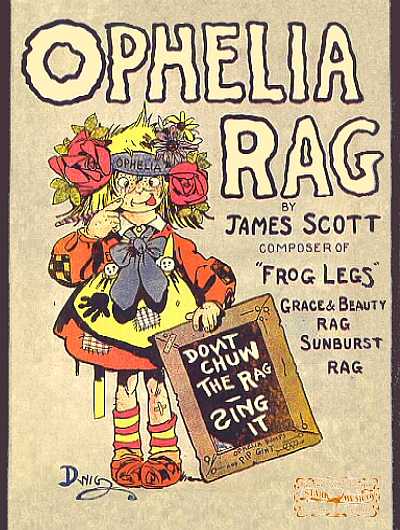
 Among Clare's running features in the beginning were J. Filliken Wilberfloss, Them Was the Happy Days (nostalgia even back then) and Leap Year Lizzie. By 1900 he was living in Philadelphia and listed as an artist, recently married to his wife Betsy Lindsay. When his works evolved into comic strips by the middle of the decade, Dwig, as he was nicknamed, produced the long-running and popular School Days, Ophelia Bumps and Her Slate, Tom Sawyer and Huck Finn, and Nipper. He also produced a number of witty and colorful post cards that are now highly collectible. Betsy was reported to have been his model for many of them.
By 1907 the couple was living in Manhattan. In the 1910 census Dwig was listed as a newspaper cartoonist. This would coincide with the time period when St. Louis publisher John Stark was also located in the New York, and would have commissioned the two covers of Dwig's work he featured. It is not clear whether composer James Scott specifically wrote Ophelia in reference to the comic series by Dwig, but he was evidently the only composer to get any covers by the cartoonist.
Dwig truly enjoyed life with a sense of humor and had a retreat at Canada Lake in the Adirondack Mountains, a location that became famous for many wild weekends and summer vacations, as well as a natural outdoor inspiration for his famous newspaper and author friends. Many of them enjoyed visits to his "Dwigwam" in the scenic woods. In 1920 he was found in Plainfield, New Jersey with Betsy, Phoebe (1910) and Donald (1913), again listed as a newspaper cartoonist. By 1930 the family had moved to more upscale Johnstown, New York, and he now listed himself as a studio cartoonist. In the late 1930s the Dwiggins family moved once again, this time to Los Angeles, California where Dwig worked with the Disney studios and as a newspaper cartoonist, the occupation he listed in the 1940 census. He also illustrated children's books including five published by August Derleth. Dwig worked nearly until his death in October 1958 in North Hollywood, California.
As Dwig often fondly remembered his small home town of Wilmington, Ohio, he likely responded well to requests from Midwest publishers for custom work. Some of his later works, such as an illustrated version of Tom Sawyer and the exploits of a character simply named Bill sold very well and are highly collectible today. On the two covers that are shown here, note Dwig's sense of whimsy mixed with madcap creativity. |

Albert Barbelle  | ||||||
Albert Barbelle was of French Canadian and American descent. Born in Fall River, Massachusetts to Alfred Wilfred Barbelle and Mary "Marie" Marcotte., Albert was the middle of five children in the family. There were other branches of the Barbelle family in Fall River as well, many of them being Albert's first cousins. His father died in the mid-1890s.
Albert spent much of his initial formal art study in his teens in both Paris and London, learning both traditional and commercial art.
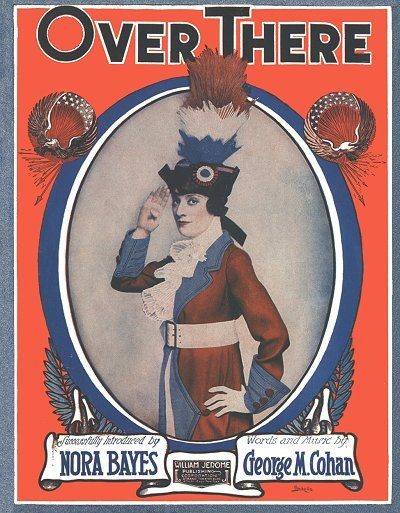
 According to a notice in Variety on January 15, 1919, Albert was the in throes of a divorce with Margaretha. The 1920 census showed Barbelle as a studio artist. It inicated that he had possibly recently married his second wife Irene K Warriex, and Alfred's mother was residing with the couple. However, the nuptials were not official until July 21, some months after the enumeration. The 1930 census still had him listed as a commercial artist. But he was not just engaged in music covers, as a July 9, 1927 notice in The Billboard noted that, "When the music business falls into a slump Albert Barbelle, title page artist, keeps busy making sketches for book jackets." He was also engaged in making signs and posters for the Broadway theatrical community. During the 1920s and 1930s his scope of work expanded into scenic artwork for the stage, and even interior decoration, very likely including some of his own custom artwork for clients.
Among Albert's more notable projects in the 1930s was providing illustrations for the important release of William Grant Still's folio of arrangements, Twelve Negro Spirituals, published by W.C. Handy in 1937. Albert's marriage to Irene ended when she died on February 24, 1934. Barbelle's involvement with music increased when he married Austrian-born composer and concert pianist Paula Fuchs on April 25, 1936, in New Rochelle New York. She was also a composer, having written Dusting Stars Around the Moon with cover artwork provided by her now-husband. The 1940 enumeration showed the couple living in Manhattan, and although Paula was listed as a piano teacher, Albert listed "radio reader" as his occupation. By 1942 he and Paula were living in Richmond, Staten Island, New York, with Albert showing only that he owned his own business, possibly his art studio, which was still in Manhattan on 45th Street. The 1950 enumeration showed Albert and Paula in Richmond, with Albert continuing to list his occupation as a commercial artist.
Later in his life Albert was able to arrange some gallery shows of his more serious beautiful paintings. Barbelle's last cover, The Party's Over from the show Bells Are Ringing, appeared late in 1956, capping a cover career of some 44 years. He was actively involved as an artist in the community, largely with the Staten Island Museum in New York City, until his death in February of 1957. Albert died just two weeks shy of his 70th birthday following two months of ill health. Paula survived him until 1975, when she passed away in Miami, Florida.
Barbelle's work was wide ranging, including enhancing photographic subjects, fantasy creations and interesting silhouettes, a series of what would now be considered politically incorrect African-American themed humorous greeting cards. He even did some work illustrating the early Mickey Mouse in print in the early 1930s, having drawn the famous Disney character for Mickey's first book. But his forte was in painting beautiful women. He was very conscious of style and fashion, and was careful to keep his work contemporary as both of those elements evolved through the decades. His use of color was more subtle than that of some artists, but always tasteful, often with one particular hue deliberately highlighting a picture for effect. The volume of work turned out in some forty years was quite impressive, with the earlier large format sheets usually signed with his full name, but later works only as Barbelle.
| ||||||

R.S. [Rosebud] - Rosenbaum Studios     | |||||||
The identity of the artist (or artists) behind this mystery signature has not, to date, been identified with any level of certainty. However, researcher Keith Emmons has uncovered the origin of the famous Rosebud Symbol and the man who ran the studio. His name was Morris Rosenbaum (German for "rose bush") who formed the Rosenbaum Studios (R.S.) in Manhattan in the early 1910s. Further research showed him to be a Russian/Polish immigrant born to contractor and builder Jacob Rosenbaum and his wife Katherine Rosenbaum who had both married at age 16 in 1878. The growing family moved to the U.S. around 1887 or 1888, shortly after Morris was born. Starting as a building contractor, Jacob later became a real-estate broker in New York City. Morris was the second oldest of six surviving children out of eight born to the couple,
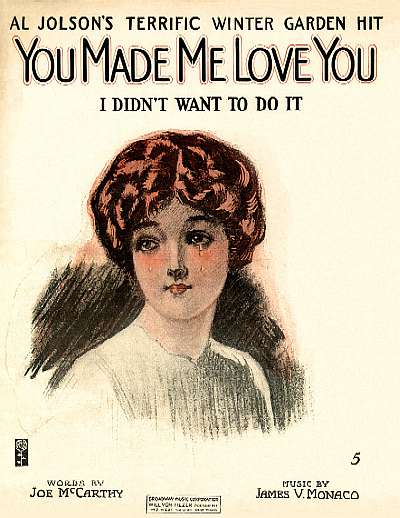
 Morris Rosenbaum is likely responsible for those cryptically signed covers with the rosebud/RS symbol which date back as far as 1906 when he was 19 or 20. The 1910 census showed him as a naturalized citizen working as an artist for a weekly art magazine and still living with his family. The same information shows on his 1918 draft registration in Manhattan. The 1916 New York City directory revealed a number of artists working for Rosenbaum Studios, giving some indication that it was a fairly busy place and a potential training ground for aspiring illustrators. They included Harold Guenther Breul from Rhode Island, Mortimer Flaum from New York City, Emil James Bistran from Poland, James Murray Mitchell from South Carolina, and Reinhold William Gundlach from Germany, all ranging in age from 19 to 38 years old.
The number of minor and major variations of the symbol alone suggest that it is likely the work of four or more artists, including Morris, which are represented over a nearly 27 year span of the studio's cover art production from West 45th Street, and later on 5th Avenue. As many as fourteen variations of the Rosebud symbol appeared with the initials R.S. on art that graced the covers of many pieces, suggesting the hand of multiple artists. Around 1913 Rosenbaum had employed the famed illustrator of the Oz books William Wallace Denslow, who was befriended by another Rosenbaum employee, Maurice Kursh. Denslow's tenure was short lived as was he, passing on in 1915.
For some time the studio was employed nearly exclusively by the Leo Feist publishing house (1912 to 1919) and later the Irving Berlin company (1919 to the late 1920s). Some covers showed just the rosebud and others the stem and rose in varying proportions. Other variations in the use of color palettes and line style on the drawings themselves further reinforce this contention. The advantage of utilizing a staffed studio was that fees were generally standardized, and the staff could be called upon to provide a wide variety of needs, such as full color drawings or simple border art for a photographic cover. As with the large number of E.T. Paull engravings from the Hoen Company, it is difficult to discern the work of individual artists' contributions, even if their names are known.
The 1920 enumeration showed Morris still residing with his parents and brother Harry and Abe in Manhattan, with his trade listed as commercial artist. Jacob was still practicing real estate. A Manhattan directory of that same year also codifies the existence of the Rosenbaum Studio with Morris as the proprietor. A 1921 article in the New York Times concerning a corrupt officer accepting bribes to help recover stolen vehicles mentions Rosenbaum as an artist, one whose car had been recently stolen from in front of his studio on 45th Street. In 1924 Rosenbaum stored a substantial coup when he was commissioned to design the logo for a recently formed film company, MGM, adopting Samuel Goldwyn's own lion logo. His iconic art work, in which the company filmed as many as four lions over the years, has remained substantially unchanged since it first appeared on screen in 1925 in films like Ben Hur.
The 1925 New York State and 1930 Federal censuses showed Morris still living with his parents, listed as a commercial artist. Fresh cover output from Rosenbaum Studios appears to have all but ceased around 1930, but he still tried to keep the business alive. An advertisement in the New York papers in 1937 was soliciting customers for Rosenbaum Studios to create advertising art. The 1940 enumeration showed him living with his widowed father, still as an artist in his own studio. On his 1942 draft registration Morris noted only that he owned his own business, likely still in graphic arts, and listed his elderly father as his contact. By the time of the 1950 census Morris, showed as having never married, was living alone in Manhattan, and was still listed as a commercial advertising artist, albeit likely on a smaller scale than in prior decades. He would die three years later in New York City at age 67, but his works have long outlasted him in their viability and often clever renditions, both by his hand and that of his talented staff. Thanks go to sheet music historian Keith Emmons who was able to locate the 1920 census record of Morris and his family listed under the name of Rosebaum. | |||||||

Henry Hutt  | ||||||||
Henry Hutt did not contribute very much to the art of sheet music covers, but he was responsible for a few significant ones. More than anything, his life was that of the eclectic and trouble artist, and very much a product of the excesses of the ragtime era, perhaps in part due to how public it was at times. He was born in 1875 in Chicago, Illinois, to teamster Georg Gotlieb Hutt, an immigrant from Württemberg (a 19th century Germanic kingdom), and his Russian wife, Dora Friedricke Will. Henry was preceded by his sisters Clara (1869) and Amanda (1871). Georg died in the mid-1870s, leaving Friedericke to raise their children on her own, working as a seamstress. The 1880 census showed them living in a Chicago tenement, probably just scraping along until the sisters could get better work to contribute to the family.
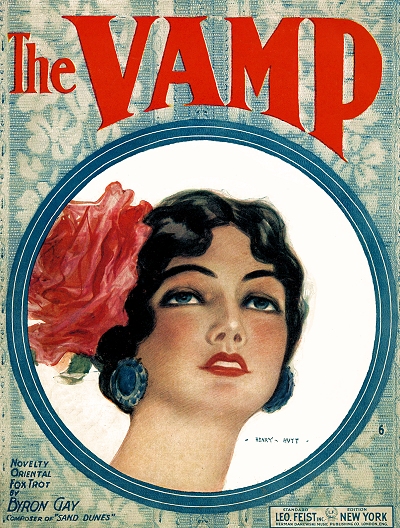
 An art editor of Mclure's Magazine took a liking to Henry's work, and engaged him to illustrate a Stephen Crane story, His Mittens. From the 1899 forward, his artwork was seen increasingly in major magazines, both as content and advertising. Before the century was out, Hutt moved to New York City where the major art centers and exhibitors were, as well as the funding for his craft. The 1900 census listed Henry as an artist living in Manhattan. That same year saw his work advertised and featured in such fine publications as The Saturday Evening Post, an earlier incarnation of Life Magazine, Ladies Home Journal, Collier's Weekly, The Century Magazine, McClures, Harper's Magazine and, most importantly and frequently, Scribner's Magazine. These were occasionally in pen and ink, but most often with partial to full color prints in wash or watercolor. Along with a few of his peers, such as Charles Dana Gibson and Harrison Fisher, Henry was known in particular for his effervescent paintings of beautiful women, to the point where they became a trend early in the decade. One in particular caught his eye, and he often referred to her as a modern-day Venus de Milo, perhaps even more beautiful. Her name was Edna Garfield Della Torre, a New York native, and from 1902 for the next several years, she would be one of his most used models. Edna and Henry were married on January 17, 1903, and their son Richard Henry was born exactly nine months later on October 17.
Henry's work was now featured in books that he illustrated, newspaper inserts and articles, magazines, and advertising material, including some images for Coca-Cola. Edna was one of many models that he used, but he quite publicly made it clear that she was the ideal model and perhaps the most beautiful in America. When the topic was broached in 1907 by French artist Masson Forestler concerning American women in particular,
"You may talk as you like, Harrison… but after all your arguments I still hold that my model is the most beautiful woman in the world." And to prove it the artist produced a photograph of his wife, saying: "Here is the most beautiful woman, not because she is my wife, but because she is truly perfect, according to the classical conception of beauty, which is above reproach and the one standard of perfection which outlasts every so-called type, that has its popularity only while its originator lives. Beauty does not live only in the brain of the idealist. It is neither a fad nor a fashion, it is a fact, as the noble outlines of the Venus de Milo prove by their time-defying loveliness." Hutt further laid out the "Ideal of Beauty Tabulated:" Height—Five feet seven inches, Eyes—Dee blue, Complexion—Very fair, rose tint, Figure—Fully rounded, Hair—Curly chestnut, with god and red lights. By 1908, people across the continent were aware not only of Henry but of Edna as well, who they saw in many of his works, even if they did not know it. However, she was clearly not the only model who caught his eye. There were newspaper spreads of his artwork showing everything from how to wear hair accessories to how to properly wear the latest fashions. In 1908, The Henry Hutt Picture Book full of his sketches and paintings was released, and became a very popular Christmas gift that year, as well as a learning tool for other aspiring artists. A follow-up in 1910 was simply titled Girls, including subjects as young as a few months in its pages. And while all seemed to be going well for Henry with his thriving business, public acclaim, and beautiful wife and loving son, there were dark rumblings behind the public persona. Based on later court descriptions from his wife and others, as well as accounts in newspapers, Henry and his artist friends were apparently a rather rowdy and unseemly bunch at times. For Hutt, it is quite probable that he was an alcoholic, and apparently did more than just sketch his female subjects. He may also have been emotionally unstable, potentially bipolar, and unaware of his limits. This first manifested itself publicly on March 8, 1909, widely reported across the country: Falling on the street [Broadway] as a result of an attack of acute hysteria, Henry Hutt, the artist whose pictures and sketches of women have spread his fame from one end of the country to the other, is now lying critically ill in a hospital in this city. Hutt gained considerable fame as an artist about ten years ago. His popularity increased and at the present time he ranks well in the front with the artists of America. Hutt's illness is believed to be due to overwork. He was married in 1903, and his wife has been the model for the greater portion of his work. When taken to the hospital it was with difficulty that he was able to tell his name. He is thirty-four years of age. As he later told it, Edna was also a perpatrator of misdeeds, and had also been abusing him physically and mentally (she was physically the size as he was). While on a visit to the Narragansett Pier in Rhode Island, while Henry was at dinner (or the gaming tables),
On January 19, 1911, it was reported that Edna brought suit against her husband for abandonment, use of "strong liquors," intimacy with other women, and cruelty. She also claimed that Hnery had prevented her in some way from becoming part of the "Four Hundred," the elite of New York society. Henry counter-claimed that "Her habits of intemperance, violence and extreme cruelty constitute a perfect defense to her action." Her extravagant spending and a similar abadonment of the home was also an issue. In a surprising move, Richard, only seven at the time, was brought in for private testimony. He sided with his mother on the issues he was asked about. Edna made it clear to the public that she did not want Henry's son to hate his father, and encouraged their relationship, then turned around and gave him a difficult time in terms of any hope of reconciliation. By April she had been granted a legal separation and $100 per month (she had asked for $500) for support. However, the New York courts were reluctant to grant her a full divorce that year, so in January, 1912, Edna and Richard moved to Reno, Nevada, where local laws of that time required only a six month residency before obtaining the final action. In the interim, Henry reportedly suffered the scorn of the general public as well as his patrons and employers, as noted in a syndicated article from January 9, 1912: Do you remember Henry Hutt, creator of the "Hutt Girls," who was kept busy not many months ago making pictures for the magazines? And do you remember Edna Garfield [Della] Torre Hutt, she whom he called his princess and used as a model and described as "more beautiful than Venus?" Well, he is down and out now and is suing to have his alimony reduced. He has brought to court papers to show that he has only $3.80 in cash, owes $5,000; that he is sick abed and his sister is paying the wages of his nurse.
Editors no longer fight for his pictures, he says. In fact, he can't get rid of them. He has showed the court a sheaf of rejection letters—the heartbreaking kind, more often received by creators who have not yet "arrived" than by artists who have just been national fads. On August 30, 1912, Edna's divorce action in Reno was denied, with the judge stating that her charges were not proven or substantiated. After a continued trial on September 16, and another one in mid-October, Edna was finally granted her final divorce. Over the next year she would nearly fade out of view, while Henry regained his footing. He also appeared in a long-running advertisement for Tuxedo Tobacco, quoted as saying "A pipeful of Tuxedo puts new life into me." There was new life, and by 1915 it appears that all was either forgiven or forgotten by the public and his fans. However, the nature of his paintings had also changed. They were still taken from life, but less focused on beautiful women and more inclusive of other subjects. His main competition in that field was still Harrison Fisher, particularly for Cosmopolitan Magazine in later years. But they were both challenged by rising star Rolf Armstrong, who would soon dominate the field of female-centric art. For a brief period from 1917 to 1920, Hutt's pictures were not just seen in the papers or magazines, but issued on the covers of sheet music. Most of these were issued by publisher Leo Feist, but a couple also curiously made it onto publications put out by Vandersloot Music in Williamsport, Pennsylvania, including the waltzes Nona and Naomi by Frederick Vandersloot himself.
On his 1918 draft record, Henry indicated his sister Amanda as his point of contact, and that he was also residing with her in Manhattan. He was not readily located in the 1920 enumeration, although Edna and the children were still living in Manhattan for that record. In 1923 Henry, now 48, married a 20-year-old model named Josephine (last name not found), and moved up to the Bronx area of New York City The 1930 census revealed that he was still an portrait artist, but also doing landscapes, and that Josephine was a model for ladies wear. Little else is known of Hutt's life beyond that, and virtually no commerical artworks were identified from the late 1920s forward, so he may have worked on gallery items and commissions from that point. Hutt remained in the Bronx until his death in 1950 at age 74.
Henry Hutt's overall body of illustrations, particularly of women, were not the highest form of art, but had an appeal that resonated with the general public. He was able to capture certain nuances and details of women that highlighted their charms, particularly his copious body of illustrations of his wife from the first decade of the 20th century. His sheet music covers, part of his later work, actually seemed pulled back a little from his earlier work, focusing on simplicity overall, while still exuding beauty, joy, or even heroic aspects. One of the most famous of his covers was actually drawn by an artist at Rosenbaum Studios. One of the four editions of Over There had a simple picture of marching soldiers (albeit in a Broadway stage manner), which was based on a Hutt sketch. Otherwise, they were focused on "the girl" and often surrounded by white, further enhancing the subject. His most complex and widely distributed cover was for The Vamp in 1920. In spite of his proclivities and at time appearing to live as a tortured and loose-moraled charcter, Hutt nonetheless provided us a window into life of the early 20th century that should still be well regarded a century and more later. | ||||||||

JVR (John Van Buren Ranck)  | ||||||
Known cryptically to sheet music collectors simply as JVR, John Van Buren Ranck was born in 1875 not far from one of the eventual sheet music publication centers, Williamsport, Pennsylvania. Whether his collective middle names were an homage to the eighth president of the United States, Martin Van Buren, or another family member, is unclear. He was the second of two known boys born to Pennsylvania natives Leonard Ranck and Emma Minnich, the older one being Thomas Franklin "Frank" (9/19/1872). They were followed by three girls, Olive Nina (11/6/1884), Mable (3/1887), and Lulu (4/1890). Both the 1880 enumeration, taken in New Columbia, Union, Pennsylvania, and the 1900 record taken in Wiliamsport, where the family had moved in 2188w, showed Leonard to be a stone mason, so an artist of sorts, given his duties were to cut and shape rocks for specific purposes.
Beyond the family listings, and, of course, his artwork, there is very little available about John on a personal level. In 1895 he was listed in the Williamsport city directory as a clerk.
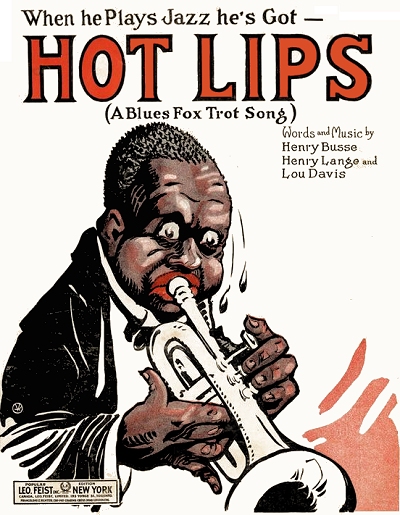
 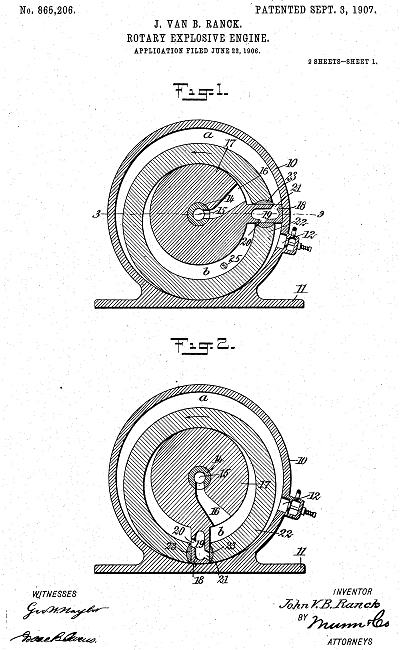 Still, he was on his way to being an illustrator in the short run, displaying other innate skills as well. Still, he was on his way to being an illustrator in the short run, displaying other innate skills as well.It is unclear where John and May were the next few years, but he surfaced in 1906 in Cleveland, Ohio, working as an artist, most likely in advertising, and possibly creating sheet music art for one or more local publishers. He clearly had some interests on the side, including auto mechanics. A 1907 U.S. Patent Office listing, #322,856, showed that Ranck had created a prototype and the basic paradigm for the internal combustion rotary engine which many decades later would be fully realized in the Wankel engine used by Mazda Motors. This was no small engineering feat, and it was followed by many other renditions by other inventors, of which most referred back to the original Ranck patent.
The Rancks remained in Cleveland through mid-1909, then relocated to Brooklyn, New York. The 1910 census showed John to be the manager and one of the artists for an art or engraving firm. One of his projects that emerged in 1912 was a set of illustrations to accompany the P.G. Wodehouse book, The Prince and Betty, which had been serialized in various newspapers that same year. In 1914 John mortgaged his property so that he could form the Powers Photo Engraving Company, and then developed a new method of creating dense half-tones in photo and lithographic engravings. Patent 761,119 was issued in his name on behalf of Powers in 1913, and the process remained in use for many decades to come, with some improvements made along the way. Part of the patent read: 1. The method of obtaining half-tone reproductions devoid of dots in the high lights, which comprises producing an original having high lights of pronounced low actinic value, and photographing such original through a screen onto a sensitized surface for a period of time sufficient to take such lower lights correctly and to eliminate the dots in the high lights of the negative by overexposure... Most of the work that John was doing during this time seemed to be for commercial advertising, theater posters, and similar projects. There were other aspects involved as well, since in the Brooklyn city directories of 1912 and 1913 he was listed as an editor, working for Powers at 203 Broadway. His WWI draft record, taken at the last call in September of 1918, indicated that he was now in business for himself as a working artist. It also showed that the family had relocated across the East and Hudson rivers to Mountain Lake, New Jersey, not far from Morristown. It would become their summer retreat. He would remain in that area for the rest of his life. Ranck, now 43, would soon be turning out sheet music covers, ensuring his artistic legacy.
As the music industry made the switch from the large format 10" x 14" sheets to the now standard 9" x 12" size, in part to save paper and ink during the war, Ranck started to provide covers for Fred Fisher, then for several years nearly exclusively for publisher Leo Feist. They were presented in a variety of styles from caricatures to silhouettes and portraits, most of them very clean in design, and virtually all signed with his unique three-initial circle, JVR. John was fortunate to have his designs on the covers of a number of substantial hits, some of which sold millions of copies over the years. The 1920 enumeration, taken in the couple's winter home Boonton, New Jersey, showed him simply as an illustrator, as he was also providing some artwork to magazines and newspapers.
By the late 1920s, there were few Ranck covers being freshly issued. Formatting had changed across most of the music publishing industry from elaborate illustrations to template designs in most instances that emphasized celebrity over content,
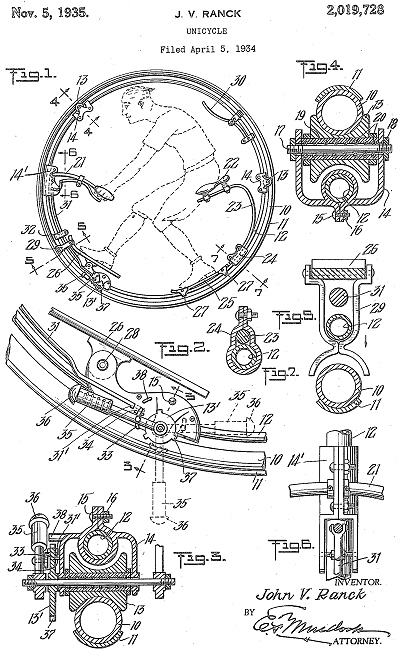 and some illustrators moved to more creative venues where they could draw more than a few interpretive squiggles to surround a picture of Rudy Vallee or Bing Crosby. The 1930 census indicated that John was an illustrator primarily for magazines now, and that May had become a real-estate broker, possibly in response to the oncoming Great Depression, but also perhaps because of the riches of properties available around Mountain Lakes. The Depression did hit the music industry rather hard, so many cover artists moved on to other fields by necessity. and some illustrators moved to more creative venues where they could draw more than a few interpretive squiggles to surround a picture of Rudy Vallee or Bing Crosby. The 1930 census indicated that John was an illustrator primarily for magazines now, and that May had become a real-estate broker, possibly in response to the oncoming Great Depression, but also perhaps because of the riches of properties available around Mountain Lakes. The Depression did hit the music industry rather hard, so many cover artists moved on to other fields by necessity.Ranck continued toying with mechanical engineering project as well, coming up with at least two interesting devices in the mid-1930s. In 1934 he patented what he called a unicycle, which was essentially a large wheel in which the driver sat within while riding. This was amplified in 1935 when another set of inventors created an early version of a unisphere riding ball that he called the toy sphere, in which the rider sat inside three wheels in different directions while remaining level as the ball moved, citing Ranck's wheel as part of the patent. While neither of these appear to have made it to market, understandable during a period when there was little disposable income, they did provide the basis for some interesting devices that were later seen in circuses or variety shows, and even some amusements intended for specialty parties. In addition, he was responsible for the syndicated comic strip Polly and Jolly, which included puzzles at the end of each installment. It ran from 1935 through 1938.
The 1940 enumeration, taken in Boonton, listed John as a commercial illustrator. It is unclear what he was doing during WWII, but it appears he took up cartooning for a while with his strip This is America, a historical and social comic on people and incidents that made the country strong. In 1949 Ranck was awarded a medal by the Freedoms Foundation of Valley Forge, Pennsylvania, for a cartoon titled To Have and To Hold. The 1950 enumeration showed him only as an artist, but now living in New York City with his wife. May died in the late 1950s, and John made it up to his 90th year before departing in November of 1965. He is buried in a family plot in Williamsburg, Pennsylvania. His many sheet music covers, an important part of his legacy, have seen increased circulation since the advent of the internet, and remain highly regarded for their artistic and communicative values, both displaying and transcending the time in which they were created. | ||||||

Grim Natwick  | |||||||||
Even though he was only involved in sheet music for a few years, the collective works of Myron Natwick have been seen at some point by most everyone in the Western world, probably more than any other artist involved in sheet music cover illustrations. But that was primarily through another medium that he took to later in his life. He was born in Grand Rapids, Wisconsin (now the western suburb of Wisconsin Rapids), in 1890 to first generation Norwegian James W. Natwick and his Wisconsin-born wife Henrietta Lyon. Some sources have claimed a last name of Nordveig for Myron at birth, and for his family. However, that was the non-Anglicized name of his Norwegian immigrant grandfather Ole Nordveig.
The 1870 enumeration has Natwig as the family name,
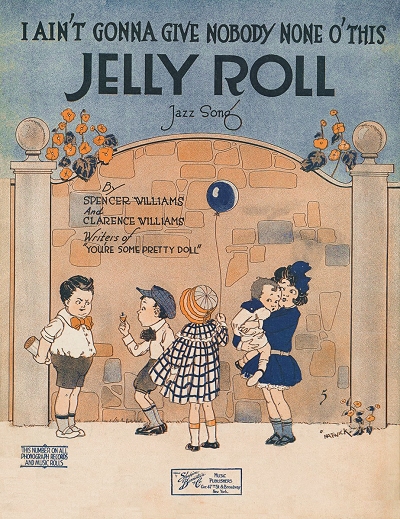
 The 1880 and 1900 enumerations both showed James as a proprietor of a furniture store in Grand Rapids. By 1900 they were doing well enough to support the employment of two domestics. The 1905 Wisconsin census showed Frank working in the relatively new field of electrician. Myron was well-liked and quite successful while attending Lincoln High School. He was a member of both the football and track teams. At age 16 he was elected captain of the track team and held the position from his sophomore to senior years. In one statewide meet in late May of 1909, as a senior, he won the 120-yard hurdle event, then second in the 220-yard hurdle, and finally third in the discus throw, as per the Grand Rapids Tribune of June 2, 1909. His brother Frank was also quite athletic, and was reportedly one of the first track athletes from Wisconsin to be invited to an Olympiad in 1908. Myron wrote poetry, some of which won the occasional newspaper submission prize, and even appeared in school plays as an actor, in addition to being the president of his senior class. However, his true passion during high school clearly became drawing, as he relayed in an interview to the [Wisconsin Rapids] Daily Tribune published July 20, 1974: The drawing interest was there in high school, however. According to things he's thrown out the past week, "I did nothing else," but draw Natwick said. A couple boxes of his old books had sketches in them, he said. Drawing was a "propelling feeling that I couldn't hold back," added Natwick. It was also part of his personality trait that gave Myron his lifelong nickname, possibly even before high school. It had to do with his "anything but Grim" attitude, and from then on - at least when it came to non-classic art forms, he was known as Grim Natwick.
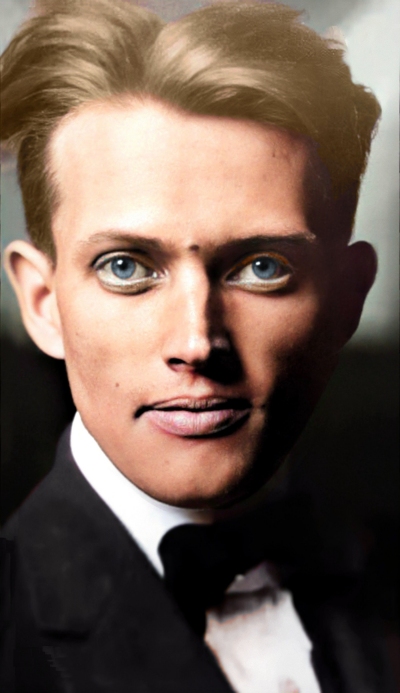 Fresh out of high school Grim headed south to Illinois and spent some of his college training at the Art Institute of Chicago. He returned home on breaks, and his visits usually managed to make it into the Daily Tribune. While he obviously continued drawing during his college years, little if any of his work created a revenue stream. However, he made friends who worked at a music publishing company, and by 1915 had been drafted to draw covers for sheet music, which helped fund his training at the National Academy of Design. Grim turned out over 100 covers for various firms throughout the next decade, even when stationed at Camp Grant near Rockford, Illinois, during the last months of World War I. Having not gone into action, he was discharged in October 1918. In the interim, he met the love of his life in Ida Lucille Wittenberg, and they were married on July 12, 1917. Fresh out of high school Grim headed south to Illinois and spent some of his college training at the Art Institute of Chicago. He returned home on breaks, and his visits usually managed to make it into the Daily Tribune. While he obviously continued drawing during his college years, little if any of his work created a revenue stream. However, he made friends who worked at a music publishing company, and by 1915 had been drafted to draw covers for sheet music, which helped fund his training at the National Academy of Design. Grim turned out over 100 covers for various firms throughout the next decade, even when stationed at Camp Grant near Rockford, Illinois, during the last months of World War I. Having not gone into action, he was discharged in October 1918. In the interim, he met the love of his life in Ida Lucille Wittenberg, and they were married on July 12, 1917.It was also in 1918 when Grim first encountered his future, albeit in a primitive form. He was hired by art school classmate Gregory LaCava at International Film Service Productions, a studio owned by William Randolph Hearst, who by then had his hands in as much media as he could. Natwick was given the opportunity to get into film animation not long after Winsor McCay had demonstrated some of his early work drawn entirely on paper, rather than the animation cells that would soon become the norm. It was a struggle at first, and he nearly quit, but when offered $100 per week to stay, a great deal in 1918, particularly considering his new matrimonial status, he finished off the frustrating task of animating a racehorse in motion. Within a short time, he turned out to be a natural at it. It is unclear if his time at Camp Grant kept him from his animator's stand outside of basic training, but with everybody pitching in, it was likely not a detriment to his position.
In early 1919, now out of the army and fully trained in several art disciplines, Natwick decided to take on what was then the graphics art center of the United States, New York City. He and Ida were found there for the January 1920 census, with Grim now working as a newspaper and animation cartoonist for the Hearst Syndicate. According to Grim concerning Hearst, "He was insane about cartoons."
Sadly, part of the return was due to Ida becoming ill. She died while in Marietta, Ohio, on March 18, 1925, living Grim a widower. Over the next few months, Natwick made several appearances in his hometown doing lectures on drawing, and even displaying some of his art from his adventure in Europe. He then returned to New York City to rejoin his career as a cover artist and cartoonist, while still creating very fine art of women, including at least one outstanding music cover for the piece You're the Only One published by the house of Jerome H. Remick. He also found work in animation, this time working to produce Krazy Kat cartoons. There were two other artists there with which he would be long associated, Jimmie "Shamus" Culhane, and Walter Lantz. After a couple of years at that studio, Grim made a couple of major changes in his life.
First, Natwick remarried, this time to Christine Frances Ferris, on May 21, 1929. Secondly, he had joined the quickly expanding animation studio of Max and David Fleischer. While 1928's Disney revelation, Steamboat Willie, was not the first sound cartoon produced, it is considered to be the first with a synchronized soundtrack, albeit done to the complete animation rather than before it was started. By 1929 others were jumping on what looked to be a lucrative bandwagon (the experiences of Disney Studios into the mid-1930s suggested otherwise), and the Fleischers were among them. They presented Grim with a record of singer Helen Kane singing I Wanna Be Loved By You or something similar, and asked if he could create the appropriate cartoon character that would be Kane's avatar of sorts. The character would be a girlfriend to their marquee cartoon star, Bimbo, a dog-like figure sort of loosely based on any number of anthropomorphic cartoonish human animals. In 1974 he recalled the task: 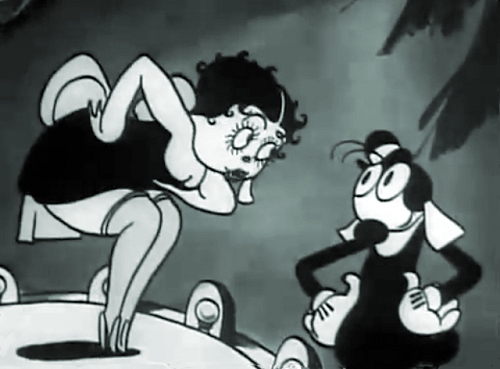 Grim Natwick based Betty Boop on a "rag time piece of music." He created her while working at the Max Fleischer studio in New York. He was given a piece of music sung by Helen Kane, Natwick recalls. She was "one of these $10,000 a night singers at that time (early 1930's) because of the 'Boop-boop-a-doop' type singing," said Natwick. In Betty's first cartoon appearance Helen Kane provided the vocals [it was actually sound-alike Margie Hines] and Miss Boop "did a little dance for two or three minutes." A little story was also woven into it, he added. Natwick said he first designed Betty "as sort of a little round faced dog. Her ears gradually became earrings. She was saying 'Boob-boop-a doop' so of course she had to be cute. [She] wore the first mini-skirt, [and] had a cute little garter with a rose in it." She was designed after Helen Kane, said Natwick, who wore "spit curls" and was, "kind of a pouty little singer." Grim Natwick based Betty Boop on a "rag time piece of music." He created her while working at the Max Fleischer studio in New York. He was given a piece of music sung by Helen Kane, Natwick recalls. She was "one of these $10,000 a night singers at that time (early 1930's) because of the 'Boop-boop-a-doop' type singing," said Natwick. In Betty's first cartoon appearance Helen Kane provided the vocals [it was actually sound-alike Margie Hines] and Miss Boop "did a little dance for two or three minutes." A little story was also woven into it, he added. Natwick said he first designed Betty "as sort of a little round faced dog. Her ears gradually became earrings. She was saying 'Boob-boop-a doop' so of course she had to be cute. [She] wore the first mini-skirt, [and] had a cute little garter with a rose in it." She was designed after Helen Kane, said Natwick, who wore "spit curls" and was, "kind of a pouty little singer."Natwick animated the first six Betty Boop cartoons which were followed by 94 more. "She was considered to be so sexy that Hollywood banned her... locked her up for years." She was "so modest" compared to what is seen on the screen today, he added. It was Grim's propensity for pronounced character animation, still a growing concept in the early 1930s, that brought him to the attention of iconic studio head, Walt Disney, and his brother Roy Disney. Based on how Betty Boop was portrayed in 1931's The Bum Bandit, Walt sent Roy cross-country from California to recruit Grim for his Hyperion studio, following the vacancy left by his former head animator, Ub Iwerks, who had left to form his own studio. Knowing some of Iwerks' accomplishments, and that he had been the core of the studio for at least four or five years, Grim, based on some inquires he made, figured that Walt was not the creative genius, so he declined a reportedly generous offer. But he and Christine, who was with child at that point, still went to California so Grim could work at Ub's studio, joining some of his fellow colleagues who had done the same. Grim was soon managing the studio for Ub, who was working on new technologies (which would later be brought back to Disney).
Nancy Ann Natick was born in Los Angeles on August 25, 1931. However, there may have already been trouble brewing in the Natwick household. At some point over the next year the couple separated, and Christine took Nancy Ann with her. They were divorced in 1934, and Christine was quickly remarried to Laddie S. Cook. Myron appears to have never remarried again. From 1931 to 1934, he and his team turned out some memorable work for Iwerks that still plays well decades later. However, at some point in late 1934 he heard the buzz that Walt was working on doing a full-length animated film. Intrigued by the possibility, Grim left Iwerks for what was now the most prominent animation studio in the world.
As always, with Disney, and even into the 21st century, they used shorts in order to work out issues in technology and technique before attempting the larger chunks, of which Snow White and the Seven Dwarfs a considerable size. Given his skill with female figures, and following a tepid attempt by others in animating Goddess of Spring (1934), he took lead on the primary female figure in The Cookie Carnival, and the satisfactory outcome put him in a lead position for Snow White. He became one of three head animators charged with bringing the heroine to life on screen, the others being Ham Luske (whom he had replaced as the lead) and Natwick's assistant, Jack Campbell. Some experts can easily tell who animated what scene, and Brim's were clearly the most deftly handled segments. He also reportedly turned out finer animation much faster than the others. The end result was a historic triumph that set a very high bar at the end of 1937 for other studios to follow.
Snow White was a "very complicated" character to draw and took up to five times as long to finish as others. Like Mickey Mouse, said Natwick, people had the idea Disney drew his own characters but when he got there 200 artists were already working for the studio, Natwick said... Over the years [Snow White] remained Disney's favorite picture, he recalls. Natwick also worked on the opening scene of what many consider Disney's most famous animation film, "Fantasia." The film was the "greatest piece of animation ever," said Natwick, but the audience in the mid-1940's wasn't ready for it. The fantasy of pictures "did not appeal to war-minded citizens," Natwick said. "Too many who might have liked it were in the Army." Although he had already done some preliminary work on Fantasia, Dumbo and Pinocchio, Natwick decided to head for a friendlier climate in late 1939. He was not readily found in the 1940 enumeration, so may have been on the road or living in temporary quarters. He had gone to Florida where Max Fleischer had relocated his studio, and spent maybe a year working with his old boss again. Among the notable features they turned out was Gulliver's Travels, but without the amalgamation of talent that Disney had in his stable, Natwick could not turn out as good of a product without that support. However, Betty Boop was still in play, and Grim worked on one of the last of her cartoons. He was then offered ownership rights to the character, but did not follow up on the necessary legal work to retain what was presented to him. When the character and her library of films was sold to King Features Syndicate many years later, Grim, who may have thought the handshake was enough, sued to get some of the take, but ended up with nothing, much to his regret.
By early 1942 Grim was back in California, living in Santa Monica when he filled out his draft record, and showing as self-employed. His contacts were still his parants in Wisconsin Falls, his father at 85 and mother at 78. During World War II, Natwick went to work with another of his old pals who had also formed his own studio, Walter Lantz.
In the 1950s, nearing what many considered a retirement age of 60, Nat was recruited for the new UPA studio in New York, which would soon become a primary provider of animation for television. They had a very simplistic style compared to Disney, MGM, or even Warner Brothers. Among their properties that he worked on was Mr. Magoo, voiced by Jim Backus. They also contracted out several television commercials for Madison Avenue firms, and industrial animations for large manufacturers. After UPA dissolved, Natwick was more or less a freelance artist,
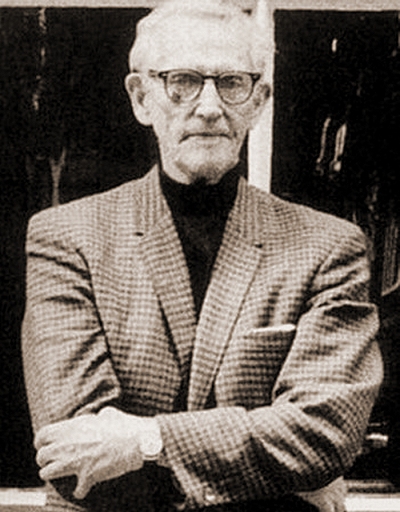 and did television work as varied as Crusader Rabbit, George of the Jungle, and other Saturday morning fare of the 1960s and 1970s. From late 1973 into the summer of 1974, Grim was in London both instructing British animators and working on the film Raggedy Ann & Andy (released 1977) at the studio of Richard Williams. and did television work as varied as Crusader Rabbit, George of the Jungle, and other Saturday morning fare of the 1960s and 1970s. From late 1973 into the summer of 1974, Grim was in London both instructing British animators and working on the film Raggedy Ann & Andy (released 1977) at the studio of Richard Williams.While Grim never fully retired, he did kick back a bit in his late eighties and enjoyed the opportunity to either present history in his field, or provide some form of mentorship and training of younger prospects. It is enticing to think of the possibilities if he had been treated a bit better and stayed at Disney. He most certainly would have been what would have been referred to as Walt's "Ten Old Men." But he still left a considerable mark on the world of entertainment, and was celebrated on his 100th birthday in 1990 at the [now defunct] Sportsman's Lodge in Studio City, California. This author, through his actor father who was a member of SAG, AFTRA and PPB, met many now-famous figures of film and animation at that venue growing up, including some who had voiced Grim's many characters, but never had the opportunity to see Natwick himself. Ward Kimball, Frank Thomas, Ollie Johnston and Chuck Jones, yes, but not the senior statesman originator of Betty Boop, who endured long enough to be represented in the 1988 feature film Who Framed Roger Rabbit. Two months after his centennial celebration, Myron "Grim" Natwick departed for another drawing board somewhere beyond, but his creations endure.
As for Natwick's catalog of sheet music covers, they presented a wide scope of his talents from whimsical caricature (some of it including Negro stereotypes that would later be deemed unacceptable) to the realism found on romantic tunes of the early-to-mid 1920s. He often worked with only one or two colors and black, but with careful shading and half-tone work was able to create a wider palette of shades that was a standout on such covers as At the League of Nations Ball. Grim also was able to impart a sense of motion in a still drawing (a hint of his potential in animation), such as with Dancing Down in Dixieland. His later covers, particularly after his European training, show a propensity for fine art and elegant female figures. Much of this would be reflected in his fine work with Disney from the mid-to-late 1930s. Much of the information here came from newspaper reports of Natwick's ongoing activities, later interviews, and the usual government records. There are also a couple of good web resources for digging further into Natwick's life and work, particularly (where some of the information was culled from) Stephen Worth's Animation Resource website, with some personal perspectives on the force that was Grim Natwick. This author, who grew up around a lot of the people Grim crossed paths with from Disney, Lantz and Warner Brothers, also recommends a view with fresh eyes of Snow White and the Seven Dwarfs to see if you can discern the differences between the three key animators who drew here (key animators drew a frame for every half second to one second of film, and in-betweeners filled the gaps between those key frames). If you are paying attention you can see which one moves the most realistically. Seek out the early Betty Boop cartoons (most of them are out there). Then find some Woody Woodpecker, just because. Ha-ha-ha-hah-hah, ha-ha-ha-hah-hah! ? | |||||||||

Gerald Stocker  | |||||||
There were many illustrators working for Tin Pan Alley that somehow stood out, perhaps due to their signature, or user of color, or overall style. They there were the champions of the common man who were lesser known utilitarian artists who nonetheless turned out consistent and high quality work that caught the eye just enough to suggest the contents within the cover as the publisher intended. In a sea of Starmers and Bucks and Dittmars, there were the quieter but still talented people like Gerald Stocker.
Gerald was born three weeks shy of 1900 in Allentown, Pennsylvania, to Frederick Freeman Stocker and Ida Mary Violet Vreeland, and had one much older sibling, Maude Iola (8/26/1881). Two other brothers born before Maude did not survive infancy. The 1900 enumeration, taken in Allentown, showed Frederick to be the foreman for a furniture manufacturer. It is unclear what kind of artistic training, if any, that Gerald received while growing up. It was most likely in New York City,
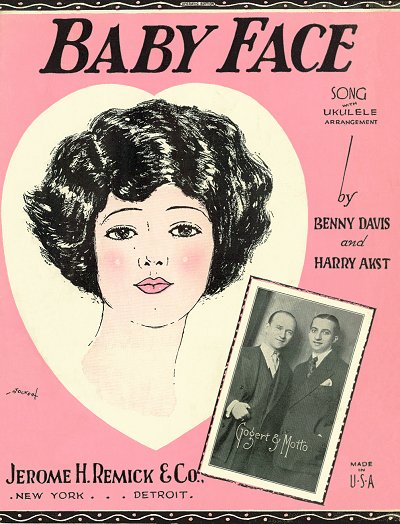
 When the United States reluctantly committed to assisting England and France in The Great War in 1917, Albert, just out of high school at 17, enlisted in the United States Army on June 15. Around the same time, his sister and uncle sold their house in Queens and moved to New Jersey, so it is unclear where Gerald was lodging for the next year. He would enter into service on May 17, 1918, and was quickly deployed to Europe with the 10th Infantry of the New York National Guard. On October 19, Gerald was wounded in action, although the degree of his injury was undetermined on his record. A later newspaper report claims he was wounded three times overall As noted in the Newrown Register on November 7, 1918: News comes from Gerald Stocker, a member of [Elmhurst Methodist] Church that he has been over the top [in battle] three times, was slightly wounded by shrapnel and gassed. He is recovering at a Base Hospital near the coast [of France]. Gerald spent seven months in a British hospital before returning to the United States in 1919. Upon his discharge and return, Sergeant Stocker sought out something that he could do to earn a living without exacerbating any wounds, or overexerting due to potential lung damage from the gas attack. He chose commercial art. The January 1920 enumeration showed him in some kind of government program, but the term is garbled, and could have been "reconnecting" or "accounting." A 1921 mention noted that he was still part of the National Guard, and had been put into service to "make sketches and do poster work." At some point in 1920 he was stationed at the Government Printing Department building in Manhattan. By mid-1921 Gerald would be working in advertising, and working as a sheet music cover artist. Most of his peers worked either independently or for a particular studio or publisher. It is unclear if Stocker was under any regular contract, but the bulk of his work from the 1920s appears to have graced covers issued by publisher Jerome H. Remick. Not all of them had his unique signature, so could only be guessed at, but he probably made a fair living with both jobs, turning out several bits of art each year.
On January 1, 1921, Gerald was married to Hazel Elizabeth Landis Zearfoss. She brought her daughter Lillian Rhoda Zearfoss (1918), a product of her first marriage, into the household in Brooklyn, New York. The 1925 New York census showed them residing there with Gerald listed as a commercial artist. By 1930, about the time his sheet music art dissipated as the Great Depression started, he was an art director for a New York advertising firm.
While he didn't skew toward absolute realism for sheet music covers, Gerald did manage to cover a great deal of ground with different tools, limited color palettes, and nice simple backgrounds. Many of his covers were caricature, but more were simple line illustrations with photographic inserts. He was perfectly capable of cartoon work, as shows in The Vulgar Boayman, silhouettes, as clearly seen on Sweet Child, and even pastels or charcoal, as demonstrated on Thanks to You. Most of his advertising work was unsigned, and therefore hard to spot, and it appears he did not do private work for pay, such as oils or watercolors. Perhaps his widest circulated cover was on the highly popular 1926 tune Baby Face. Many thanks for the nudge from Norman Gholson von Holtzendorff to tackle this biography of Gerald Stocker. Most of the information came from newspaper mentions, with a few leads from a single family tree on Ancestry.com. The father of Lillian Zearfoss, Hazel's first husband, was difficult to track down. | |||||||

Joseph and Saul Wohlman  | ||||||
Joseph and Saul Wohlman were part of a multi-talented family that was somewhat grounded in the entertainment and art business. Born in New York to Austrian Yiddish immigrants Herman Wohlman and his wife Celia Feirstein, they had four other siblings including Irving M. (3/1889), David (3/28/1890), Alexander (2/22/1893) and Beatrice "Bessie" (1897). Saul's birth date at time of death was shown to be March 26, but his WWI draft record showed March 4, which may be more accurate. Herman worked in the garment industry in a cloak factory. Irving started his own successful sign painting business in Manhattan. David was a salesman for music publisher F.J.A Forster, eventually opening his own music store in New York in the 1920s. Alexander worked in the theatrical business in various guises, listed as an actor in the 1910 and 1920 census. He was also the commercial manager for the Gilbert & Friedland theatrical firm.

 While little information has emerged on any training given to the brothers, which might have included Irving, as of the 1917 draft Solomon listed himself as an artist, living in Havana, Cuba at that time as a conscientious objector to the war. In 1918, Joseph was listed as a commercial artist who had received a medical discharge shortly after his registration. By 1920 he had added photographer to the commercial artist listing. As of the 1920 census most of the family was still living in Manhattan on West 172 Street, but Saul seems to have evaded that record, perhaps still living in Cuba. Irving married his wife Bessie in the late 1910s. He then started his own sign business across the river in Newark, New Jersey around 1919, with Bessie listed as the president of the firm. They had one child that did not survive infancy, but by the time of the 1930 census they had both a boy and a girl in their home. David married his wife Dorothy around 1921 and by 1930 was no longer in the music business, working in beverages instead. Alexander eventually left the stage to become a full time theatrical manager. Saul returned to New York City after the armistice.
Covers attributed to Saul (S. Wohlman) started appearing in 1919, perhaps the earliest ones drawn in Cuba, having been commissioned and delivered through the mail. Those from Wohlman Studios (Wohlman) made their debut around 1920. Given their collective history in the industry, Joseph was possibly the founder of the firm, and Saul the artistic force behind it. For the next fifteen years many artful covers and magazine advertisements or illustrations appeared with the Wohlman name on them. In retrospect, many of the Wohlman covers were more graphic than they were art, as the brothers went into business at a time when the music industry was creating new standards for cover size. Most publishers abandoned the larger 10"x13" covers during the war, and used more templates that could be repurposed for a number of different pieces. They still managed quite a few originals that were very elegant and steeped in the Art Deco trend of the 1920s. It is unclear if other artists worked for the firm. However, it is probable that the more colorful painted half-tone artwork, and even much of the graphic line art was done by Saul, while some of the line art and the layouts were handled by Joseph.
In the mid-1930s Saul and his mother Celia had moved to Oceanside, New York, away from the city, still listing himself as an artist in the local directories. Joseph and his wife, Sophie Rothstein, whom he had married in the early 1920s, were still living in Newark with their daughter Muriel Ruth. By 1940 he had joined Irving as a salesman with the sign company. As of the 1942 draft, Irving was still running his sign company in Newark, but Saul and Joseph were not part of that record, perhaps due to previous exemptions. The 1950 enumeration showed Saul in Manhattan with his wife and daughter, and he listed his occupation as "penscript work" for advertising houses. Irving was difficult to trace in that year's record. Beyond 1950 there is little trace of the Wohlman brothers except for their deaths, both in New York a dozen years apart. They left behind several hundred music covers and graphics in other media as well, certainly help to contribute to and even set some standards for the generic but elegant style of sheet music seen throughout the jazz age and beyond. | ||||||

Eralso Errol Walton  | ||||||
Eralso Errol Walton was known largely by his initials, E.E. Walton, during his professional life, which involved illustrating for a number of New York City firms. He was born in Cross Plains, Tennessee, anywhere from 1871 to 1877, depending on which account is the most credible. The earlier year is probable, given the lack of a World War I draft record, and that he was the oldest child of Professor of Humanities, John Martin Walton, LL. D. and Adelaine "Addie" Augusta Blackman, who were wed on November 27, 1870, in Williamson, Tennessee. It can be accepted that he might also have been born as late as 1875, but no later. Eralso's younger siblings included Newell Blackman (4/1879) and John M., Jr. (11/1885).
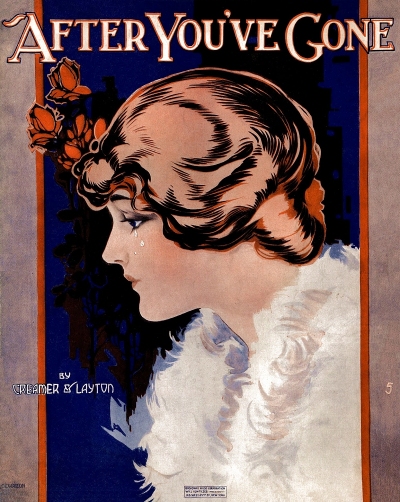
 As for Eralso, his whereabouts from the 1880s into the early 1900s were very hard to trace, even with his unique name. It is assumed he went to an art college in either Tennessee, Alabama, or perhaps New York, where he would end up. However, his identity was verified as distinct from a man using the name Eralso Walton during this period, who was sought throughout the 1890s and caught around 1899 after bilking several people in fake land deals and other securities crimes. This may well be one of the reasons he used his initials (common for artists) instead of his name in his work. Starting at some point around 1910, possibly before, he became a lithographer and engraver in New York City, working for advertising firms and providing images for books and magazines. The 1915 and 1918/1919 Trow's Copartnership and Corporation Directory for New York show him as co-owner of the Advertising Art and Engraving Company, along with William J. Miller.
The bulk of Walton's sheet music covers were created during World War I and shortly after, a time in which sending the right message with the right cover image was essential to keep up morale and, of course, sell music to commemorate the struggle of the brave boys overseas. His artwork skewed toward simplistic realism with the use of two or three colors, an economy partly dictated by the times, in concert with shrinking the size of sheet music covers as well as the music within. Walton did very few caricatures into the early 1920s, focusing more on the fine art aspect. Some of his covers are more about design than image, as they forecast the trend of the 1920s and later of including celebrity photographs rather than an image reflective of the lyrics. His last known sheet music covers were in the late 1920s. It should be noted here, also, that no discernible relationship between Eralso and the "Walton Process" used to print sheet music in Chicago was discovered, thus the name is likely coincidence.
Eralso's personal life was harder to decode, but there were a few clues. From the mid-1910s into the early 1920s he cohabitated with a woman known as Alice G. Walton, confirmed by the 1920 census taken in Manhattan, New York, and a later legal finding. The 1922 New York City directory showed him now as running the Walton Art Studio at 11½ 26th Street in Manhattan. Walton was separated from Alice by the mid-1920s, with no evidence of the couple having married or had children. He was married to Katherine Isabel Reynolds on July 12, 1926. After her death in late 1937, Katherine's sister filed suit against her will, of which Eralso was executor, claiming that his relationship to Alice G. should have been considered a common-law marriage (seven or more years at that time), and that he had therefore committed bigamy when he married Katherine. After months of deliberation, a November 5, 1938, finding showed that no evidence of marriage had been found for Eralso and Alice, and that an attempt to anul the relationship was declared invalid because of the lack of marriage evidence.
While Walton somehow evaded the 125 New York and 1930 and 1940 Federal enumerations, a 1939 notice showed him granting some land in Delaware to one Ella R. Ocks, the relationship being unknown. In 1942, he curiously registered for the World War II draft, citing his year of birth as 1886, some 14 years off from his likely actual age of 69, which explains his status as retired. Even more curious, he listed Alice Walton living at 230 Park Avenue, New York, as his point of contact, suggesting that the relationship had either come back in some capacity, or never fully ended. The 1950 census showed him living in New York city, but now widowed and unable to work. His listed age of 78 actually suggested an 1871 birth. Eralso died 4 years later in the spring of 1954, and was interred at the Fresh Pond Crematory and Columbarium in Middle Village, Queens, New York. His sheet music covers remain collectible into the 21st century both in online libraries and sheet music sales sites. | ||||||

Lionel S. Reiss   | ||||||
Lionel Reiss was not a major contributor to sheet music art, but he nonetheless raised the bar for some artists in his fine work, following it up with some highly contemplative paintings and sketches based on his own Jewish heritage. Lionel was born in Jaroslaw, Poland, (which had been annexed by Austria at that time) to Meyer Reiss and Rachel Rubenfeld. His family immigrated to the United States in either 1898 or 1900 (the latter date was used more consistently in official documents despite biographies showing the earlier year) and immediately settled on the Lower East Side of Manhattan between the Brooklyn Bridge and the financial district, a heavily ethnic area in the early 20th century. The move had been necessitated by the increasing amount of vilification of Jews in Austria, Germany and Russia that would only increase over the next four decades.
While little is known of Lionel's upbringing, he did study commercial art in his teens, and by the time he was 20 was already working in that field for newspapers, and for a printing house that provided art for advertising and magazines.
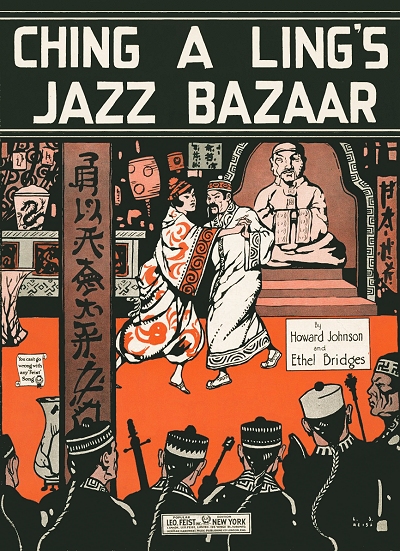
 Looking for a more meaningful use for his art, Lionel went back to Europe. Reports of dates vary, but at least one trip was done in early 1920 (explaining his absence from that year's enumeration),
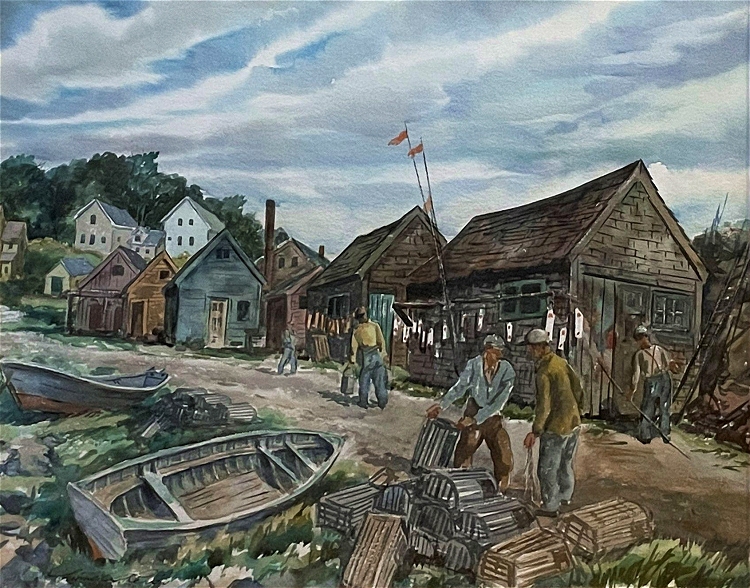 then another from 1922 into the fall of 1923, and it is probable there was even another one in the early 1930s. During these sojourns Lionel traveled to ghettos, villages and shtetls in the old world looking to study, and then capture Jewish life in sketches and canvases. Other trips were made during this period into the Near East and North African nations. The works he created ultimately made their way into major art gallery exhibitions around the United States in the late 1920s and into the 1930s. These included a wide variety of colorful background venues, although great attention was given to the facial features, hair, body types and clothing of the subjects. Many of these images were released via a book in 1938, about the time the Holocaust was starting in Germany, titled My Models Were Jews. Acting as an adjunct sociologist of sorts, Lionel was trying to make the argument that there was no Jewish "race," as Adolf Hitler was attempting to claim, but only a highly diverse collective of believers in the faith, trying to counter common misconceptions about the people of his heritage. He followed this up nearly a decade after the war and the Holocaust had ended with a 1954 book titled New Lights and Old Shadows, contrasting shadows of the past with the hope of a reborn Israel. One final book published in 1972, A World of Twilight, with text by Isaac Bashevis Singer and Milton Hindus, used some of Lionel's collective art over time to portray pre-Holocaust life throughout Eastern Europe. His artworks remain in many galleries and collections of Jewish heritage today, and are often displayed. A large body of American experience art from his hand is also out in the world. then another from 1922 into the fall of 1923, and it is probable there was even another one in the early 1930s. During these sojourns Lionel traveled to ghettos, villages and shtetls in the old world looking to study, and then capture Jewish life in sketches and canvases. Other trips were made during this period into the Near East and North African nations. The works he created ultimately made their way into major art gallery exhibitions around the United States in the late 1920s and into the 1930s. These included a wide variety of colorful background venues, although great attention was given to the facial features, hair, body types and clothing of the subjects. Many of these images were released via a book in 1938, about the time the Holocaust was starting in Germany, titled My Models Were Jews. Acting as an adjunct sociologist of sorts, Lionel was trying to make the argument that there was no Jewish "race," as Adolf Hitler was attempting to claim, but only a highly diverse collective of believers in the faith, trying to counter common misconceptions about the people of his heritage. He followed this up nearly a decade after the war and the Holocaust had ended with a 1954 book titled New Lights and Old Shadows, contrasting shadows of the past with the hope of a reborn Israel. One final book published in 1972, A World of Twilight, with text by Isaac Bashevis Singer and Milton Hindus, used some of Lionel's collective art over time to portray pre-Holocaust life throughout Eastern Europe. His artworks remain in many galleries and collections of Jewish heritage today, and are often displayed. A large body of American experience art from his hand is also out in the world.Outside of his work on Jewish subjects, Lionel continued his commercial art career, likely to help sustain his other work in fine art. While sheet music covers appear to have only rarely been in his repertoire from 1921 to 1926, he still did some work for magazines and newspapers.
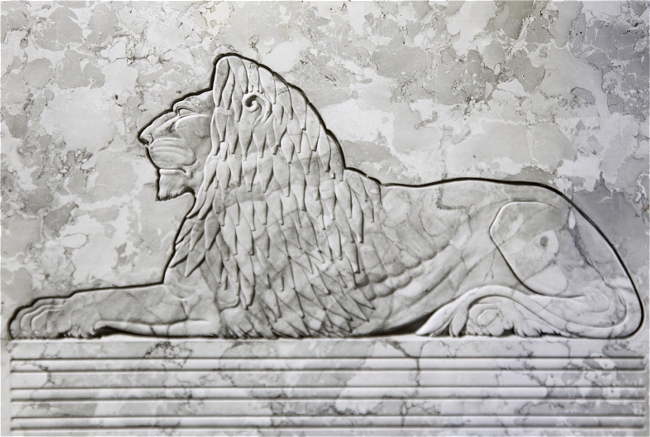 At one point, Lionel worked for Paramount film studios in New York as an art director. In that capacity he was engaged by Goldwyn Pictures, before their 1924 merger with Louis B. Mayer's studio, to design the reclining lion logo on a pedestal. It was often used even after the merger that created Metro Goldwyn Mayer. However, it appears that by 1930 Reiss was able to make a sustainable living primarily through his canvases. The census for that year showed him living at 78 W. 55th Street in Manhattan in a building occupied by numerous other artists and illustrators, simply claiming "art" as his vocation. He was also engaged for book illustrations now and then, which generated a decent influx of funds. Many of his depictions of life in New York were acquired by collectors of fine art and displayed in the city's galleries. At one point, Lionel worked for Paramount film studios in New York as an art director. In that capacity he was engaged by Goldwyn Pictures, before their 1924 merger with Louis B. Mayer's studio, to design the reclining lion logo on a pedestal. It was often used even after the merger that created Metro Goldwyn Mayer. However, it appears that by 1930 Reiss was able to make a sustainable living primarily through his canvases. The census for that year showed him living at 78 W. 55th Street in Manhattan in a building occupied by numerous other artists and illustrators, simply claiming "art" as his vocation. He was also engaged for book illustrations now and then, which generated a decent influx of funds. Many of his depictions of life in New York were acquired by collectors of fine art and displayed in the city's galleries.The Great Depression likely put a damper on his business, yet following the publication of his first collection, Lionel was able to afford an apartment at 370 Central Park West at 97th Street, where he was found for the 1940 enumeration and when he filled out his 1942 draft record. During the prior decade, he was married to Frances G. Grossel on December 4, 1935, and their son David was born around 1938. The 1950 census showed the family still living iat Central Paqrk West, and Lionel the proprietor of his own art studio. Outside of travel, Lionel spent the remainder of his long life in New York, participating in Jewish social and support events and gallery exhibitions into his eighties. Frances died in the early 1980s, and Lionel passed in April of 1988 at age 94. He was buried at Mount Ararat Cemetery in East Farmingdale, Suffolk County, New York.
While the general focus of Lionel's fine art are mentioned above, the style of his music covers was a bit different, but no less worthy of attention. Despite the richness of his canvas work, the Reiss covers are much simpler in their line, and some use subtle shading to suggest dimensionality. Some had detailed backgrounds, but most follow the "less is more" paradigm. His subjects skew toward realism in many ways, although some of his earlier work approaches a mild exaggeration of caricature. With perhaps the exception of Ching-A-Ling's Jazz Bazaar, Lionel carefully avoided stereotyped ethnic images, and even that work is not horribly offensive, even by modern standards. Elegance was a keyword, and many of the images, of which their primary purpose was to bring attention to the consumer to check out the music inside, are sustainable as works of fine lithographic art based on their own merit. | ||||||

Frederick S. Manning   | ||||||
Few sheet music cover artists were able to capture the essence of beautiful women quite the way Frederick Stewart Manning was able to. He actually entered that specific field as a second career of sorts later than most artists, being in his mid-thirties when his music covers started appearing. Frederick was born in Port Huron, Michigan, in 1874 to British immigrant Thomas E. Manning and his Illinois born wife Jane M. Stewart. He had two sisters, including Clara (1878) and Pearl (1881). Fred's family moved to St Paul, Minnesota when he was very young, and they appear there in the 1880 census, Fred listed as the misspelled Stuart.
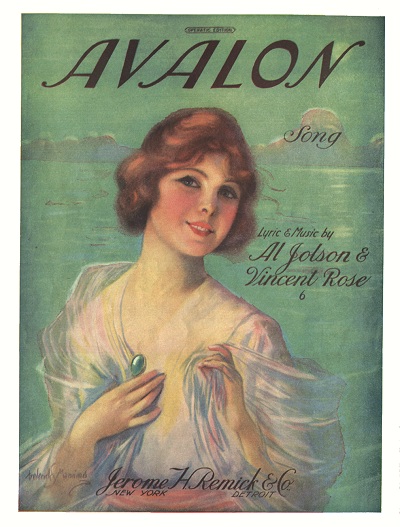
 In the mid-1880s the family moved down to Colorado Springs, Colorado, in part to help with Jane's worsening health. She subsequently passed on in 1892. Much of Manning's early artwork which originated in that state was in the field of comic panels and strips of the late 19th century, working for the Colorado Springs Gazette. He also taught penmanship and possibly drawing at Guinn Commercial College in the same town. On October 4, 1893, Frederick married Canadian native Harriet "Hattie" Irene Tremell, in her first trimester of pregnancy. Their son Frederick Lyle was born on April 21, 1894. The young family moved to Denver around 1899, and Fred found work as an advertising and commercial artist for the Palmer-Ellinghausen Company. The 1900 census listed Fred in Denver, Colorado with Hattie and six year-old Lyle. His avocation shown at that time was as a magazine artist.
As Frederick's talents and experience increased, the family moved to Chicago. They soon added Thomas R. to the family on May 22, 1905. While in Chicago Fred did more commercial and comic art, including cartoons for the Chicago Tribune and the Chicago Evening Post. He also illustrated a book of poetry, Sweethearts Always, compiled by Janet Madison. Some of his first sheet music cover art appeared in Chicago as well, some of it uncredited. Fred is shown in the 1910 census in Chicago with Hattie and sons Lyle and Thomas, listed as a portrait artist, another of his lines of work that would become more prominent.
In 1911 the Mannings moved to New York City with Frederick in search of a more serious and profitable career in advertising artwork. He scored quickly, creating ad art for companies as varied as the Union Pacific Railroad and Coca Cola. His work soon caught the eye of Will Von Tilzer of Broadway Music, and publisher Leo Feist, and he produced covers for them. He was also a member of the Society of Independent Artists, and exhibited with them during shows held in the late 1910s. Manning's passion for fine portraits continued to surface, and portrait artist is the vocation shown on his 1918 draft card, registered on Staten Island where the family was now living. Lyle had registered the year before, and likely served, but Frederick remained stateside.
In the 1920 census Frederick was listed as a landscape artist, and his wife inexplicably with the name Josephine. This misidentification led to a notion by researchers that Manning had possibly been divorced, but further information proves this to be untrue. Lyle was also starting his own career as a commercial artist around this time. From 1919 to the late 1920s Frederick produced a number of beautiful and elegant covers for publisher Jerome H. Remick, most of which remain highly collectible decades later. In a Colorado article uncovered by researcher Keith Emmons, it was announced that Frederick and his sisters had each inherited the substantial sum of $200,000 from a great grandfather. With this he eventually moved back to Staten Island into a house in Donegan Hills, commuting on the famous Staten Island Ferry to his Manhattan studio. The 1925 New York census, however, may have been taken before this time, as Frederick, Hattie and Thomas were living on 14th Street on the north side of the somewhat Bohemian area of Greenwich Village, surrounded by other artists, musicians and theater folk. In 1929 Frederick received a commission for a portrait of national hero, pilot Charles Lindbergh, Jr., which currently can be seen at the Minnesota Historical Society.
While a number of artists simply followed requested ideas or even submitted their own conceptions for final use without question, Manning was always sensitive to his clients in that he wanted them to be satisfied with what he produced. Therefore, working on his experience in advertising, he would submit a watercolor draft of each concept to the publisher for selection or final approval. Then he would create his works, using paid models, in either watercolor or pastels with occasional ink highlights. He reportedly received $150 a cover from Remick for the bulk of his work in the 1920s, which although a decent wage back then is roughly only two to three times what one copy of some of his more collectible covers sell for currently.
Although much of Manning's earlier work is signed with the full signature represented above, he would occasionally use only his initials (F.S.M. - as on the comical Christopher Columbus), or in later years only his last name. As of the 1930 census, Thomas was seen living with Hattie and working as an assistant vice president for an electric company, but Frederick appears to have missed that record, perhaps on travel at that time. In subsequent years he and Hattie moved to Matawan, New Jersey. When the demand for cover artists of his type faded in the 1930s, he continued serious painting by public or private commission until shortly before his death. The 1950 enumeration showed the couple now residing in Manhattan, but with no occupations listed. Lyle, who had enjoyed a career of his own as a commercial artist, died in September of 1959. Frederick S. Manning passed on at age 85 in 1960 in Matawan. Hattie survived the both until 1968. The beauty Manning captured in his subjects of yesteryear lives on today in vivid hues, which affirms the old saying that beauty is truly ageless. Thanks go to Frederick's step-grandaughter through Thomas' second wife, Carrie Leoni, for relaying memories of a period when she lived at the Manning household in Matawan, New Jersey, which dispelled the notion of divorce and helped to prompt further research on Manning. | ||||||

Rolf Armstrong  | |||||||
Although Rolf Armstrong is well-known to sheet music collectors of 1920s material, his legacy actually goes far beyond that distribution medium, as does his fame, all in the name of art. John Scott Armstrong was the last of four children (by two decades) born to Canadian immigrant Richard Armstrong and his wife Harriet Scott, the other three being William Noah (1866), Cholula (or Chula) (8/6/1867) and Paul (4/25/1869). Richard was nearly 50 when his youngest son was born in Bay City, Michigan, and was already nearing the end of his career as a fire boat builder and tugboat/excursion captain on Saginaw Bay and Lake Huron. He also ran a farm at his residence, although the future of that and his boat business was already in question as John reached toddler status. The Bay City Daily Tribune of February 22, 1890, quoted the elder Armstrong as saying: There is no longer a decent livelihood to be made in river trade... I will neither run a saloon, pander to low elements, or run my boats on Sunday and because of this I see no profit to river service. You may say, then, that my whole outfit, steamboats and all, is for sale. I cannot see a livelihood in this business and want to sell out. If anyone else can he may get my boats cheap... I will sell out, if I can, failing I shall do the next best thing. Place my boats as advantageously as possible and keep some of them on the river so long as they will pay expenses. However, despite the gloomy prognostication, Armstrong managed to survive the next two years. Then in late 1892 he got a lucrative contract with the World's Columbian Exposition held in Chicago, Illinois,
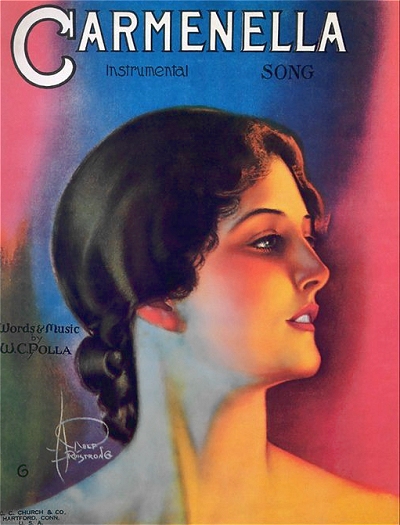
 Harriet and John relocated west to Seattle, Washington, where William had gone to manage interests in various mines in Alaska and Canada, and would eventually participate in Frederick Cook's unsuccessful attempt to reach the peak of Mount Denali. Jack made the decision to work as a clerk for a steamship company, a trade he knew, rather than to go to school. This was likely to help support his mother during this time. He also pursued his personal interest in sketching and painting, self-developing his skill for the most part with some advice given here and there. By 1908, when he was 19, John had decided in a career as an artist, but wanted further training. He managed to enroll in the Arts Institute of Chicago where he furthered his education and refined his skill. Some of his tuition was offset by tutoring other students, such was his talent. His self-portrait from around 1908 (a detail of which is the left picture at the top) showed innate skill, but it also showed him to be a strikingly handsome individual as well. Along with charm, these traits and his natural abilities took him far in forwarding his career. It is uncertain exactly when and why John took on the more exotic Germanic name of Rolf (columnist Walter Winchell later reported that it was from numerology), but he was using it regularly before 1910, and given the subsequent documents it appears on, he possibly used it legally as well, even though his birth name was noted in the press several times through the time of his death.
Rolf found his way to New York City around 1911, and quickly found work through his considerable talent, and many friends as well. He was also called on to illustrate and provide covers for numerous books and magazines during the 1910s. While some appeared in newspapers, one of the more lucrative high-exposure gigs was with the Puck periodical.
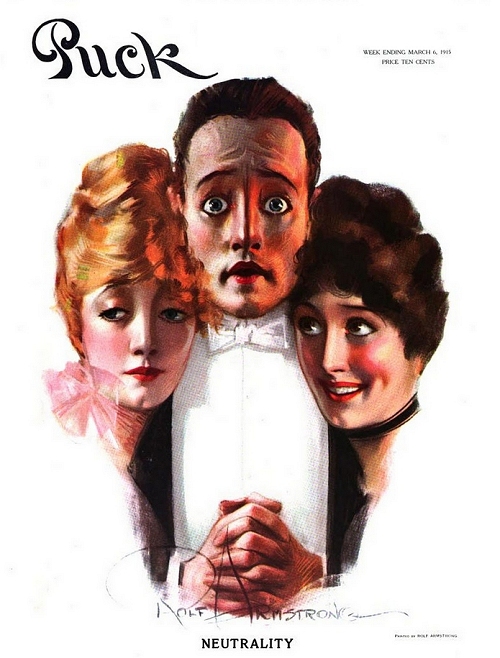 One cover in particular stands out, playing on the burning question of American neutrality with the European war in 1915. It shows a gentleman trying to hold a nervously neutral stance between two attractive women, but also served as a metaphor for what many Americans were feeling at that time, which articles inside that March 6, 1915, issue extrapolated upon. There were many sightings of Rolf with his brother Paul, who had become a noted playwright, at New York diners and the track at Saratoga Springs. One cover in particular stands out, playing on the burning question of American neutrality with the European war in 1915. It shows a gentleman trying to hold a nervously neutral stance between two attractive women, but also served as a metaphor for what many Americans were feeling at that time, which articles inside that March 6, 1915, issue extrapolated upon. There were many sightings of Rolf with his brother Paul, who had become a noted playwright, at New York diners and the track at Saratoga Springs.A New York Tribune article from March 18, 1917, in reference to frequent meetings held at the Biltmore Hotel ballroom, called Armstrong and his New York city peers, more based in the serious art world than just cover illustrators, part of "Art's Melting Pot." He was also called out as one of more prominent artists who had worked on patriotic posters during the United States' involvement in World War I, along with Howard Chandler Christy, Charles Dana Gibson and James Montgomery Flagg, creator of the famed "I Want You!" Uncle Sam recruitment poster. Armstrong's contributions were for the U.S. Navy, and as part of a campaign to recruit workers at the shipyard located at Port Jefferson, Long Island. As for direct participation in the war, on his draft record, filled out on June 5, 1917, Armstrong claimed exemption due to a left arm compound fracture. This did not keep him from some of his favorite recreational activities or social events such as horse races and grand parties. One of his favorite passions was born in the family business of his youth out on the water, although now recreational, as Rolf was an avid participant in boat races and regattas, landing mentions of him in many New York newspapers.
In October of 1919 Rolf was married to 19-year-old actress Claire Louise Frisbie. It was around this time that his work started appearing on sheet music covers, largely from the C.C. Church house of Hartford, Connecticut, as well as J. Stasny and M. Witmark in New York. The majority of these memorable images were of beautiful women in pastels, and virtually all of them were reproduced in four to six color processes, more elaborate and expensive than most traditional covers up to that time. His closest competition was Frederick S. Manning, who did very fine similar work for Jerome Remick. The 1920 census taken in Manhattan showed Armstrong working as a commercial artist, and having been married, but Claire was not listed at the same address.
Throughout the next decade Armstrong's work was highly celebrated, if also commercialized. Rolf's paintings were included as advertising giveaways, found as newspaper supplements, although by the mid-1920s the sheet music covers were no longer one of his products. The Vatican in Rome, Italy, even released a series of postage stamps with Armstrong images of beautiful women. Thanks to a collaboration with the advertising firm of Brown and Bigelow, Armstrong became one of he earliest creators of the calendar girl in the early 1920s, and continued with that trend for nearly three decades. Rolf had a pool of young women that he worked with, having selected some of them from beauty contests he was tapped to judge, along with many of his peers. But he also managed, so it appears, to stay out of trouble, rarely espousing any political or social views, and just enjoying the high life. He was also rather well off, living in a nice home on Bell Boulevard in Bayside at Little Neck Bay, Long Island. The 1930 census showed Rolf and Claire hosting a Japanese servant in the home as well. Curiously, the Armstrongs claimed to have not aged over the past decade, with Rolf still claiming to be 30.
The 1930s would prove to be hard for the United States and the world in general with the Great Depression. While Rolf was not immune to the economic hardships, he fared better than many, and his work was still in demand, as was his opinion. In general, according to a quote found in newspapers in the 1950s, "He insists his models must have that 'amateur look', and when [she] hangs on a wall, she makes a man feel 'doggone lucky' to be in the same room." In an article on the "Standard of Feminine Beauty" in the July 11, 1931 issue of The Billboard, Armstrong waxed on his personal opinion of what that standard should be: Rolf Armstrong, who draws them in most kissable temptation, holds out for the old-fashioned idea of "ancient classical standards of proportions." Armstrong believes that these old Greek standards still govern beauty and states that "certain harmonious proportions may produce a type that is picturesque or piquant, but the more perfect the beauty the more exactly it conforms to the Greek standard.
"If the face is lovely," says Rolf, "it will dominate defects of figure. And since beauty is composed of such definite things as structure, texture and color, it can be affected only slightly by personality" He is a gentleman who prefers brunets [sic], 'tis said, and in discussing types he stated that. "Blonde, brunet [sic] or redhead may be supreme. It all depends on how closely she approximates the idea of her particular type. I have observed, however, that ultimate perfection is more often approached by brunets [sic] than by the other types." Now, if that isn’t just too sweet for us girls of the brunet [sic] persuasion. Time we got a break, anyway. Rolf continued his passion for regattas and yachting as well as other forms of boating and canoeing, winning some championships along the way, and competing at an international level. Much of his artwork was now relegated to magazines and a variety of celebrated calendars, plus a few private commissions.
Given that Rolf himself had movie star looks and charisma, there were the expected veiled rumors about dalliances with his many models, some of them painted in the nude, although none were ever confirmed in public. Just the same, with several strains on their personal life, not the least being his hobbies and active social life, the Armstrongs were divorced in December of 1939, with Claire claiming desertion. There is, however, a possibility that she instigated or made the dissolution necessary. In an interesting twist, the divorce was granted in Reno, Nevada, on December 30, while in the courtroom next door, Rolf's nephew Robert was also obtaining a divorce from his wife Gladys Dubois. Robert and Claire would be married within two months, probably raising a lot of eyebrows and creating a familial tension. Rolf would soon retreat back to New York City.
The 1940 census showed Armstrong residing with lawyer Phelan Beale in Manhattan, along with another lodger, Esther Hellberg, who was a private masseuse. As Phelan was listed as a "partner," a designation often used during that period to denote certain living situations, it might raise some questions about Armstrong's sexual identity at that time, and possibly another potential reason for the end of his marriage. However, as abundant evidence survives to suggest an entirely heterosexual existence, his relationship with the lawyer could be considered either experimental or simply miscast, and nothing definitive remains in that respect. By the time of the 1942 draft Rolf was back in Bayside where he would retain a home for the remainder of his life. The "Dean of American Girl Painters" would continue to create calendars and other art throughout most of the decade. He was still viable and quotable in the 1950s as well, and in 1954 in an article concerning modeling trends for the following year, was noted as saying with just a hint of objectification: The average man is not interested in the gaunt body with a crew haircut. Men like luscious curves. Anybody who doesn't believe that should notice how all eyes trail Italian girls. The 1950 census was taken while he was staying in his 67th Street apartment in Manhattan, with the occupation as simply "artist." Armstrong remained active in art during the 1950s, although more for private than commercial clients. In 1959 he went to Honolulu, Hawaii, to do some painting, but took ill in the late winter of 1960. Rolf died of heart disease at age 70. He was cremated and his ashes scattered from the overlook at Nuuanu Pali near the southeast corner of Oahu. His legacy lives on in thousands of highly regarded works of art across a wide spectrum of products and mediums, highly valued by art and music collectors alike. | |||||||

Helen Van Doorn Morgan  | ||||||
Helen Van Doorn Morgan has long been a mystery in terms of who she was, although her sheet music cover art is well-known to collectors. There are many inaccuracies in listings that include her name, including her true birthplace, birth year and year of death (meaning that the traditionally cited 1902-1986 lifespan is not correct). It was relatively difficult to find anything in official records on Ms. Morgan until her actual birth name was discovered, so hopefully this article will stand as a new and correct reference to this talented illustrator.
Helen was born in Quincy, Illinois, in the summer of 1899 to St. Louis, Missouri osteopath Dr. Herman Fred Goetz and his Illinois native wife Jessie Allison Morgan, who had been married in 1895. The 1900 census taken in Quincy showed the couple living with Jessie's parents, Joseph Morgan and her daughter's namesake Helen Van Doorn.
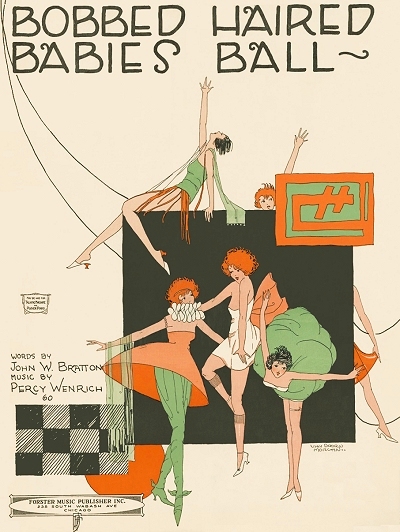
 During the 1910s both Helen and her brother Joseph (called by his middle name of Morgan for much of that period) managed to get formal training in commercial and fine arts. Helen was working for an art studio by 1919, and she declared as such for the 1920 census. In addition to what was potentially advertising art and posters, Helen, now using her mother's maiden name of Morgan, also started providing sheet music cover art to the F.J.A. Forster publishing house. A couple of them were featured on works composed by ragtime composer Charles L. Johnson for his post-ragtime publications. She would sign many of the Forster images from 1919 to 1926, and would also provide a handful for other Midwest publishers, including Milton Weil and Ernest Clinton Keithley. A 1923 Chicago directory showed Helen employed as an artist at 59 E. Van Buren Street. By this time, Joseph (having also taken his mother's name of Morgan) was working as a commercial artist as well.
Most likely in mid-to-late 1927, Helen and her brother and mother relocated to New York City. There she continued her career in commercial and sheet music art, now providing images largely for DeSylva, Brown and Henderson as well as the Red Star music publishing company. The 1930 census showed the family residing in Manhattan, all now officially using the last name of Morgan, as Helen had done for over a decade. The following year, Joseph was married and moved out of the residence.
After this the trail grows a bit thin, however there is enough to construct an overall narrative. It is difficult to find any of Helen's art gracing sheet music covers after 1930, so she was likely a victim of the Great Depression in that regard. However, she continued creating everything from paintings and sketches to sculptures, and even the occasional magazine cover. Helen was not readily located in the 1940 enumeration, so her whereabouts during the mid-1930s to around 1940 are unclear, albeit likely in New York or Pennsylvania. By the early 1940s Helen was married to Robert John Ruskin Williams (8/26/1885), a divorced artist also working in New York City. As he had been working in that field in Chicago in the early 1920s, it is highly likely they had known each other for some time. The couple was living in Carversville in far eastern Pennsylvania in the early 1940s.
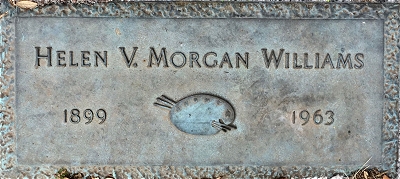 When Jessie died in 1946 following a serious fall, she was buried in Carversville, thus verifying the connection between Helen and Robert, as she had signed the informant slot on the death certificate as Helen Williams. When Jessie died in 1946 following a serious fall, she was buried in Carversville, thus verifying the connection between Helen and Robert, as she had signed the informant slot on the death certificate as Helen Williams.The 1950 census showed Robert, as Ruskin, and Helen, residing in Solebury, near Carversville. He was listed as a commercial artist for an advertising firm, and Helen surprisingly showed no occupation. In later years, Helen and Robert lived somewhere between Manatee and Sarasota in west-central Florida. Helen died in Sarasota in 1963 just three days after her 64th birthday. Robert died nearly three years later in Manatee at age 80. Both are resting at Sarasota Memorial Park, and the markers for each of them have an identical relief of an artist's palette with three brushes.
As for Helen's sheet music style, which was created predominantly from 1920 to 1930, it echoes many elements of the Art Deco school of that time, and could be described as simple for the most part, using a muted but earthy and harmonious color palette. This allowed focus on her human subjects, most of which were tall, thin and elegant. Many of the covers are vertically inclined, one of the characteristics of Art Deco. While not as prolific as many of her male peers, her name still stands out a century later as an important contributor to the transitional age of sheet music from the whimsical styles of the ragtime era to the largely templated style of the 1930s. | ||||||

Irving Politzer  | ||||||
Irving Politzer left mostly his art behind as his legacy, but little else in terms of biographical material. That given, here are the facts that were found. Irving was born in Manhattan, New York, at the end of the 19th century, the only child of Hungarian immigrants Morris Politzer and Emma Goodman. The 1900 enumeration showed Morris to be a barber, family residing in the lower East Side on Eighth Street, a heavily Jewish neighborhood at that time. Both the 1905 New York and 1910 Federal censuses showed the same vocation, but in 1910 the family took advantage of the northward migration made possible by the new subway system, and were now found in The Bronx just north of the Harlem River. The 1915 New York census found the family back in Manhattan, with Morris now working as a whiskey distributor,
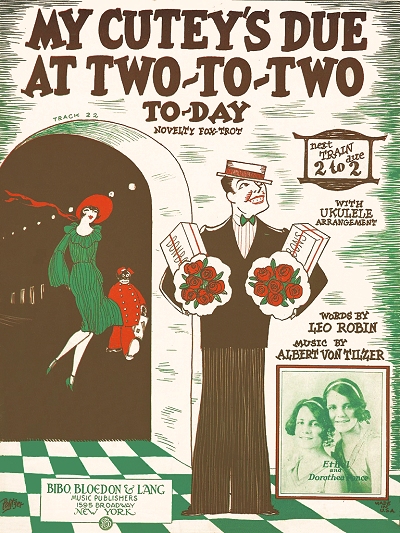
 The kind of training that Irving had in order to equip him as an illustrator is unclear, but it was not uncommon for artists at that time to apprentice for a printer or lithographer. Indeed, his last-call World War I draft card showed him as an apprentice working at the Allendorff Studio. Indeed, he was one of the early pioneers of cartoon animation, working briefly for the Animated Advertising Company of New York, and holding membership with the Harris Art Society, as per the April 1917 edition of Cartoons Magazine. However, Irving did little in the field of cartooning or animation after the 1910s.
It is unclear if he got into the sheet music illustration business with Allendorff, but he eventually became an independent contractor. His sheet music covers, at least 80 and perhaps more, appeared mostly from the early 1920s into the early 1930s. However, Irving was also engaged often to do advertising in magazines, and in particular, some striking book covers and illustrations. A notice in the Boston [Massachusetts] Evening Transcript of May 13, 1930, noted that there was a exhibition of his cover artwork at the American Bookseller's Association convention held in that city. And despite the universally tough conditions experienced by many during the Great Depression, Irving did well for himself since people were still buying sheet music, and in particular, books with which they could find some escape from the world around them. A September 1936 notice in the Meriden [Connecticut] Record noted that Irving, along with colleague Arthur Hawkins, were the primary producers of most of the book jackets seen during that time
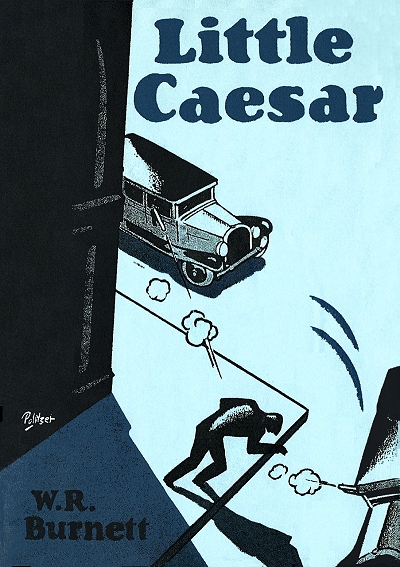 (paperbacks were not quite in vogue yet), and that was earning them around $10,000 each per year, a tidy sum during that period. (paperbacks were not quite in vogue yet), and that was earning them around $10,000 each per year, a tidy sum during that period.While newspaper notices of Irving were extremely scant, it is clear he continued his successful career as a New York illustrator into the 1960s, as he was found listing that avocation in city directories from the early 1920s until at least 1962. After his father died in 1919, the artist lived with his mother Emma until the end of her life in the early 1940s, as per census records from 1920 to 1940, and his World War II draft card. After her death, now in his late forties, Irving got married to dress shop owner Tesse H. Sharpe in August of 1946, and remained with her to the end of his life. The 1950 census showed the couple living on the west side of lower Manhattan. Irving died at age 72 in March of 1971, and was interred at the Hastings on Hudson cemetery in Greenburgh, Westchester, New York.
The style of Irving Politzer was not really revolutionary, but there were some clear allusions to the Art Deco style that was popular in the 1920s and 1930s. Many of his book cover illustrations were shadowy silhouettes, perfect for mystery novels and similar pulp fiction fare. When there were human subjects on his sheet music covers, he focused more on them than he died on detailed backgrounds, but there are a few exceptions. Only a limited number of them show strong caricatures, the bulk of his cover art mostly straddling a line between light simple realism and hints of cartoon-like representations. Politzer would occasionally use patterns, as seen on such covers as I Ain't Got Nobody and My Cutey's Due at Tow-To-Two Today, but for the most part he favored simple two or three color and black images. Irving did have the good fortune of having his art featured on some of the more widely distributed tunes of the 1920s, and as has often been the case with illustrators, may have had some hand in creating consumer interest in the music due to his eye-catching covers. | ||||||

Sydney Leff  | ||||||
Sydney Lefkowitz was born in Brooklyn, New York, in 1901. He was the youngest of eight children of Austro-Hungarian immigrants Joseph Lefkowitz, a poultry salesman, and Rose Berger. His siblings included Mildred (1888), Israel (1889), Henry (1890), Samuel (1892), Celia (1894), Abraham (1897), and Emmanuel (1899). In 1910 the family was shown living in Brooklyn. While Sydney desired to be an artist at a young age, he did not want to be a starving artist. So he pursued commercial art early on, recognizing the viability of doing so in the growing fields of magazine and sheet music illustration.
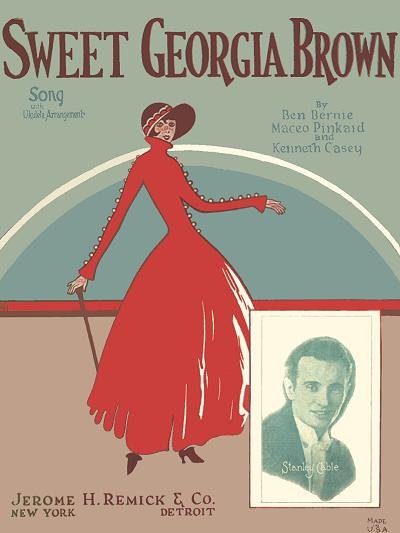
 Some of Sydney's first commercial work was produced while he was still in high school, and continued as he took a long subway commute from Brooklyn each afternoon to attend the vocational National Academy of Design in East Harlem, with fellow classmate Al Hirschfeld, another iconic 20th century artist. He appeared in the 1920 census at age 18 working as an artist in a studio. In 1923 Sydney, who had by now anglicized his name to Leff, answered an advertisement from lyricist Sam Coslow who was looking for a new cover artist. The initial jobs paid $15, but he was soon able to command much more. The simple yet eye catching style translated into a lot of contract work for the young artist, and he was known to turn out three to four covers a day at some point at $25 each, ultimately completing over 2000 of them.
Clearly reflecting the hair and clothing styles of the 1920s in his art, many of Leff's covers could be categorized as Urban or Moderne. He was both highly involved and evolved in his cover artwork during the bulk of the Art Deco era of the 1920s and 1930s. He appeared as a commercial artist in the 1930 census, living in Brooklyn with his wife of Russian descent, Rita Zion, whom he had married in 1928. Rita was also a talented illustrator, which was likely how they met. During the subsequent decade the Leffs had two daughters, Joan (1931) and Gail (1934). The 1940 enumeration also showed Syd to be a commercial artist. However, Leff retired from producing music covers in the 1940s as more of them were featuring celebrity photographs than they did art.
The next obvious move was to advertising, in which he became somewhat of an icon on Madison Avenue. The 1950 census showed him as the proprietor of an advertising agency. Sydney lost his wife Rita in 1979. After another retirement, Leff tried marketing some of his older sheet music drawings again on calendars, mugs, and other merchandise, with limited success. Still, his work had staying power, a point that was emphasized as recently as 2000 when some of his covers were featured in a cabaret music exhibit at the Museum of the City of New York with Mr. Leff in attendance. He finally passed on at his assisted living residence in December of 2005 at age 104.
One word that describes Leff's style might be contrast. Whether it be in shading or through starkly different yet complimentary covers, he was able to bring out the parts of the cover that were most relevant to the song within. Irving Berlin in particular used Leff for a large number of publications during his career in part because of the artist's command of relevance, and they became close friends. Leff also conveyed emotion and attitude, partially through facial expression but also through the use of body language. His comic covers are whimsical in both content and proportion without overdoing the caricature aspect. | ||||||

Benjamin "Jorj" Harris/Georgette Harris   | |||||||
Benjamin Harris was a pioneer in airbrush art in popular media, and along with his wife Georgette became a big proponent of the Art Deco style of the 1930s. While they are not directly related in style to many of the ragtime era cover artists in this collection, their work is both a follow-up to and evolution of those who came before them in creating memorable sheet music art. Note that some websites erroneously reference to them as African American artists, but they were, in fact, born Caucasian, and showed as such in all relevant records.
Ben was born in Albany, Georgia, to plumbing contractor and handyman Edward Payne Harris and his wife Eva Lillian Joiner. Edward was reportedly a not-too-distant relative of famous Uncle Remus author Joel Chandler Harris,
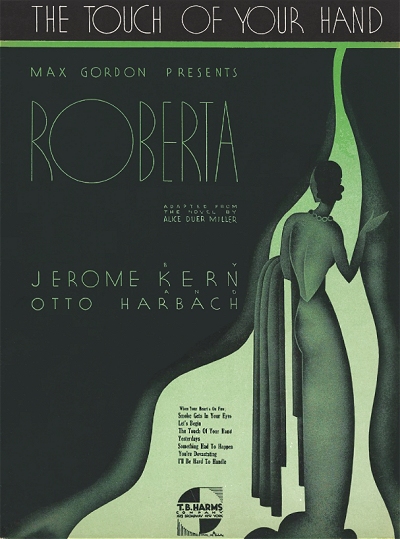
 Georgette Oberdorfer was born in New York City two years before Ben to first generation New York natives, druggist Johann George Oberdorfer and his wife Lillian Ammann. Lillian died in late May of 1904, and soon thereafter Georgette was sent to live with her German immigrant maternal grandparents, Charles and Elizabeth Ammann in Yonkers, New York, where she spent her youth. Her father still ran his drug store on 8th Avenue in Harlem for many years into the 1920s, but their relationship during that time is unknown. Georgette showed early promise as an artist, and was trained in graphic arts during the early to mid-1920s.
By 1930 both Ben and Georgette were working as freelance commercial artists for some New York firms, with Ben engaging in sheet music covers from early in the decade. The 1930 census showed Ben living now in New Rochelle with his older brother Edward who was a broker, and working as a standard engraving artist. By this time he had received training in architecture, and practiced professional photography as well. At some point he also obtained a pilot's license. Georgette, who had graduated in the early 1920s from Skidmore College, had been working for New York area newspapers as both a journalist and cartoonist, but soon fell into the graphic arts sector of publishing. Having taken to the growing medium of airbrushing, she was soon teaching at the College of New Rochelle, and would eventually be hired as an art director for the Warner Brothers' music publishing division after their music catalog acquisitions made viable by the addition of sound in films. In 1930 Georgette was lodging with the family of divorcée Ruth C. Harris, the last name likely not a coincidence, but the direct relationship to Ben not readily discerned.
Ben was good at caricatures and illustrations, and was often engaged to provide the latter for special interest newspaper stories and books. Georgette leaned more toward working with silhouettes and shadows with Art Deco themes utilizing long lines with elegant curves. As they often collaborated on images, they created the collective signature name of "Jorj" after Georgette. Ben often used it as his middle name, a tribute to his partner that also made him quite unique. As sheet music covers and other forms of art had moved away from traditional lithography into offset printing, it made for a more expedient process of getting their works into print using techniques that would be all but impossible with the use of lithographic stones. Among the more revolutionary and breathtaking tools they used was the airbrush that Georgette had been working with for some time, as it could easily create feathered edges and disappearing horizons. Although it had been around since the 1870s, the airbrush had largely been used as a photo retouching tool rather than a primary form of painting. In the 1947 the couple would publish a book on the use of airbrushing for those interested in progressing in that form.
In the world of music, although the Harrises were independent contractors, both together and separately, their biggest client appears to have been Harms music and its subsidiaries. This was significant in that they were publishing a great many show-related tunes from Broadway. Their methodology towards creating images was discussed in a 1998 New York Times article on sheet music artists, which also referenced one of the oldest remaining such individuals of that time, Sydney Leff (also in this collection). … Sheet music was among the least glamorous of graphic design commissions. Walt Reed, the co-owner of Illustration House and the unofficial historian of the New York-based Society of Illustrators, called sheet-music designing "a lowly area of illustration."
"It didn't pay well," he added, "and was often only a way to start a career. It was an anonymous business, a transitory occupation."
Sydney Leff, who is probably the last surviving sheet-music artist who worked in the 1920's and 30's, conceded that "covers were a degraded form of art, and not fine art, but it spoke of the time, probably more than the written word did."
[Performer Michael] Feinstein agreed, calling the "Porgy and Bess" illustration "a perfect evocation of the period, and of what Gershwin was trying to do with the music." "The Harrises," he added, "must have heard a good deal of the score before executing the cover, since it's a miniature encapsulation of the story."
Apparently they did. "In the case of musical productions, where there is a number of songs," they wrote in their book, "we talk the show over with the authors and try to arrive at a simple design, which tells the story of the show and still looks more or less appropriate for the song titles."
In the middle ground one sees the ramshackle Catfish Row ("Summertime") and the crippled Porgy in his goat-cart ("I Got Plenty o' Nuttin' "). The man in the checkered suit, paired with Bess in profile, is not Porgy but her lover Sportin' Life ("It Ain't Necessarily So"), seducing her with skyscraper dreams ("There's a Boat That's Leavin' Soon for New York").
The Harrises wrote, "The airbrush is a modern medium, and drawings done with it should be modern in feeling." And in the esthetic context of the 1930's, this illustration [Porgy and Bess cover] is modern art. Among the couple's more interesting projects was working for the noted firm of Newman Decor, which focused on decorating some of the better apartments of the New York area during the late 1940s. With contributions from the Harrises and other artists, they provided scores of airbrushed and watercolor paintings with which to festoon the domiciles and lend some class and an air of sophistication. They covered a number of subjects from floral arrangements to fashion and gentleman's sports. Hundreds of these works are still widely regarded and collected today through art and auction sites. Ben and Georgette also continued to flourish in the world of advertising for some time, adapting their Art Deco strengths into layouts for periodicals and print ads.
Ben ran his studio into the 1940s and, according to a couple of directories, the early 1950s. Indeed, the 1950 census, taken in New Rochelle, showed the couple both as free lance artists who owned their business. However, by that time, advertising trends had changed greatly, as had sheet music cover topics and content. It is not clear how long he and Georgette provided original images for Newman, but the modernization of the mid-1950s into the 1960s appeared to have essentially outmoded them. Ben died at the end of 1957 at the relatively young age of 53. Georgette survived him for nearly six years, passing on in the fall of 1963 at age 60. They are a great example of a power couple who shared a passion, not just with each other, but with a grateful world that still recognizes the beautiful esthetic of their revolutionary work. | |||||||

Bill Edwards  | ||||||
Being the type of person who wants to be pretty good at everything rather than regarded the best at any one thing, and also because I like having my hands on every possible aspect of what I do, I slowly became involved in producing cover art for my own music. I had some art training during my regular secondary school education, and got involved in graphic arts in college, with more emphasis on design than painting or rendering. I have also studied animation art, again not the same as static art forms. So I went into this with at least some notion of an artistic eye as well as practical real world experience in drawing that went beyond paint by numbers (although I did pretty good on those).

 Initially my artistic production was limited to cassette covers in the 1980s, some done on one of the early models of the Macintosh computer. But as the tools became more sophisticated, I found that I was able to produce interesting cassette/CD covers as well as those for sheet music. On a very primitive graphics rendering program I was able to replicate a faux-Schirmer cover for Hanon Rag on an early Tandy computer in 1985. Once computer generated (CG) art became a legitimate form both in movies and in real world graphics, I felt less inhibited about my manual drawing limitations and was able to exercise some freedom in creating relevant covers with a modicum of confidence. I then set out to slowly recapture the art of producing sheet music covers.
Somewhere along the way, likely during the 1930s, photographically produced covers became cheaper to produce than those with colorful cover art. For starters, many more people were able to take photographs than those who possessed the talent to draw or paint relevant artwork. Then there is the factor of celebrity endorsement, which photography best represented. By the 1970s, a larger number of covers were regressing back to text-only format with minimal or no art at all. So when I started producing ragtime covers I did it within the capabilities of the tools I had. The initial covers were plays on the ubiquitous G. Schirmer yellow books with some minor alterations. The Hanon Rag and Ragtime Nocturne logically fit into this mold. But when the titles became more descriptive, I figured that some kind of artwork was necessary.
In the case of Pride of the Prairie, Lovely Laughing Lucille, Ragtime Bobolink (by Joseph Lamb), Snuggle Pup (by George L. Cobb) and The Ragtime Pamela, I turned photographs into a mix of watercolor and pastels in an attempt to create something that looked painted or drawn. For The Necromancer, I was fortunate to have an appropriate drawing given to me by noted artist and former Washington Redskin George Nock, which I incorporated with a custom text logo. The Wiener Schnitzel Rag is an attempt at cartoon watercolor, and was done by my own hand. Ragapples was also rendered by a number of painting and computer generated techniques from individually photographed or scanned elements. Charleston Claude (by Vincent M. Johnson) was a PhotoShop hack recreating an old Gene Buck cover with a bit of whimsy. As my skills increase in both manual and computer art I am sure that future covers will be more adventurous, and will hopefully recapture to some extent those days when cover art was a prominent feature or enhancement of sheet music. | ||||||

 |
The Ragtime Webring-Dedicated to Scott Joplin and the music of the Ragtime Era, this ring is an invaluable resource for jazz music lovers, musicians and historians. Sheet music, midi files, afro-american history, record collectors... |
| | Previous | Next | Random Site | Ring Hub | Add Your Ragtime Site | | |
|
There are lots of great ragtime recordings by top artists available from

Including some of my recommended favorites:
And don't miss these movies which include some ragtime music:
| ||||||||||||||||||||||||||||||||||||||||||||
|
Or just search their site using the search engine below! | ||||||||||||||||||||||||||||||||||||||||||||

| ||||||||||||||||||||||||||||||||||||||||||||